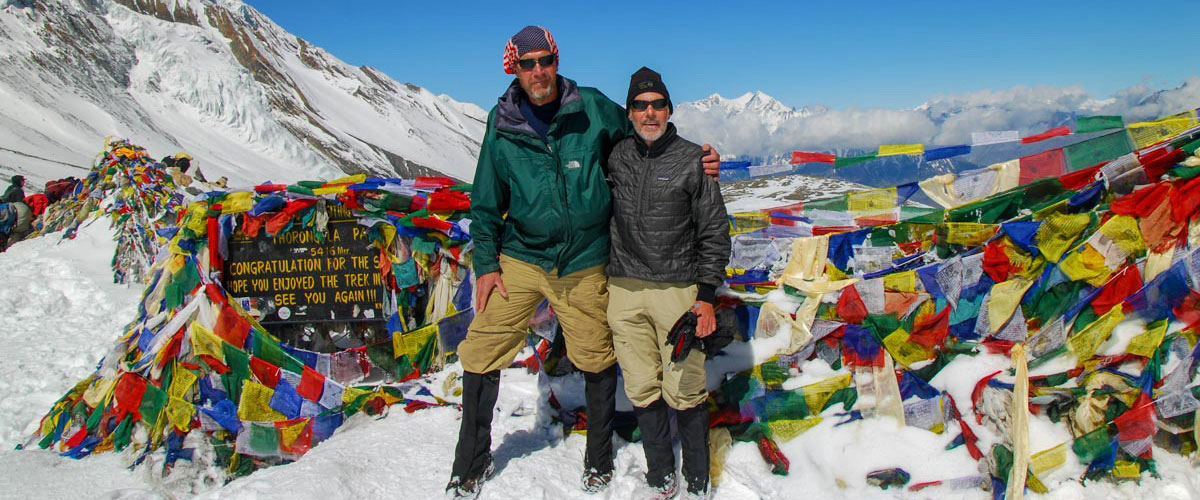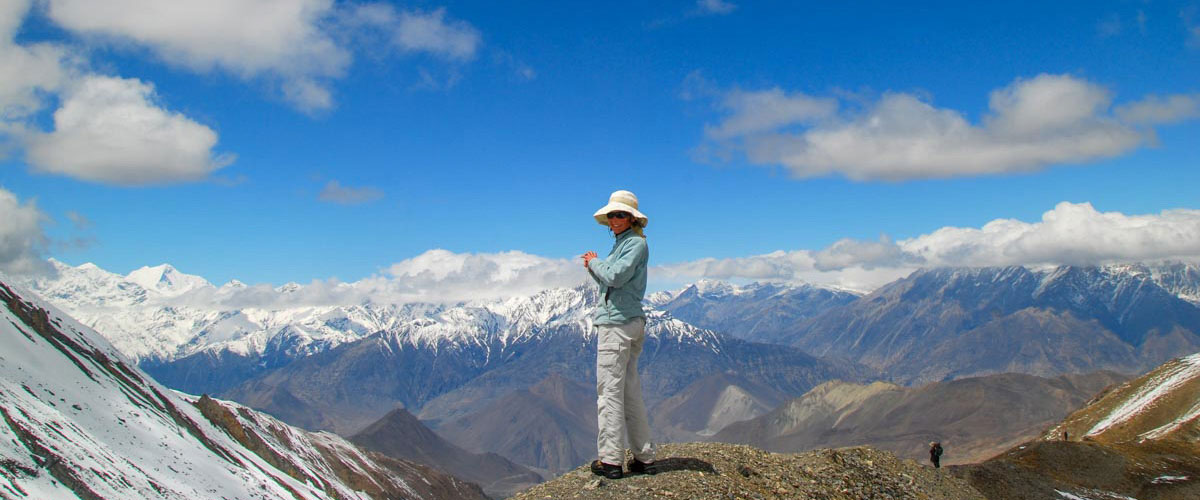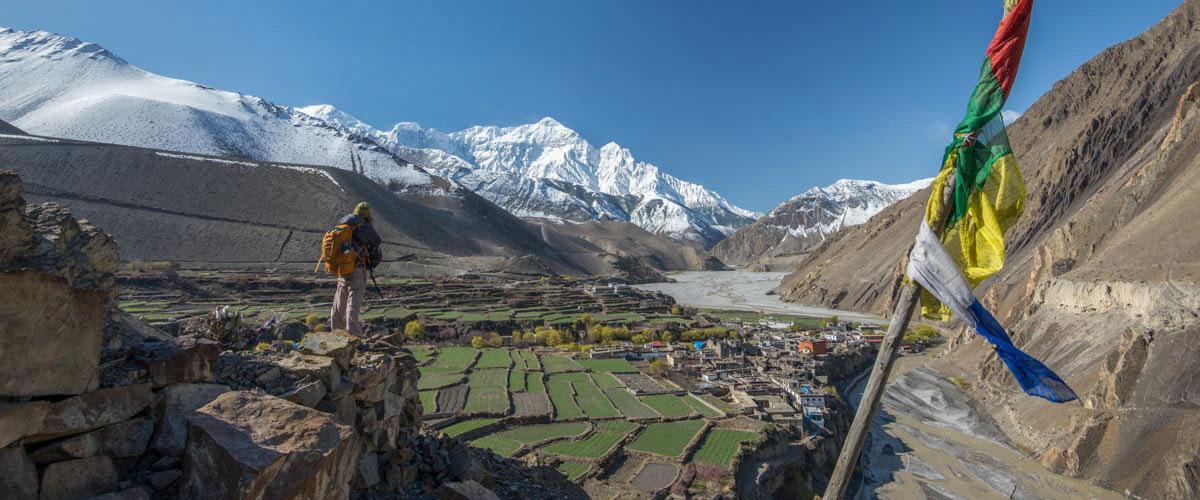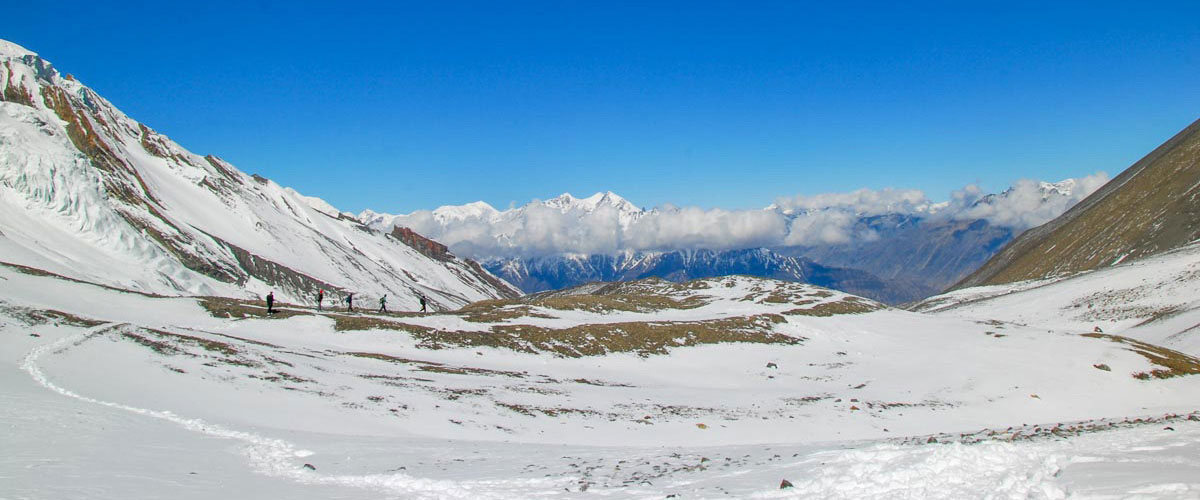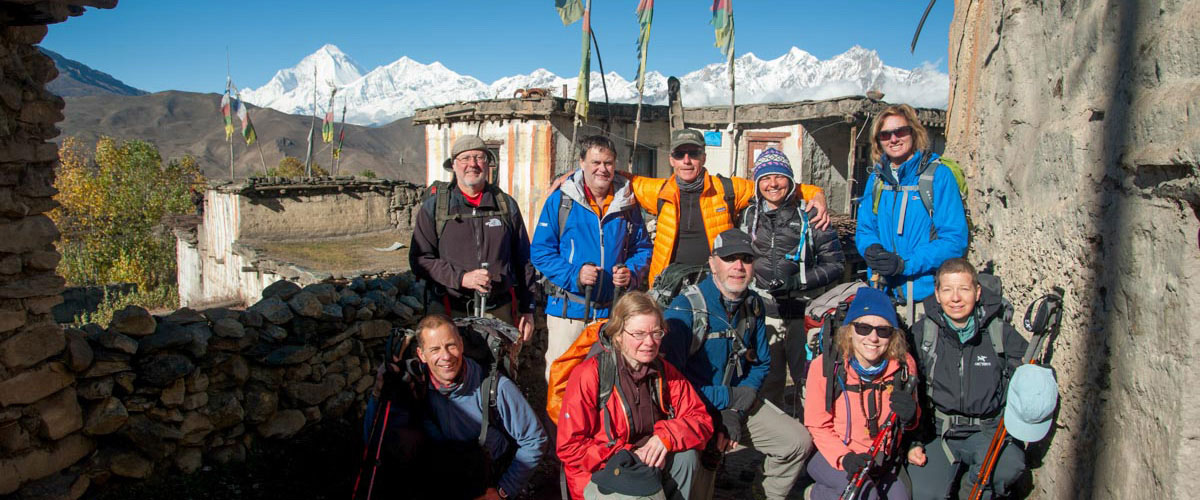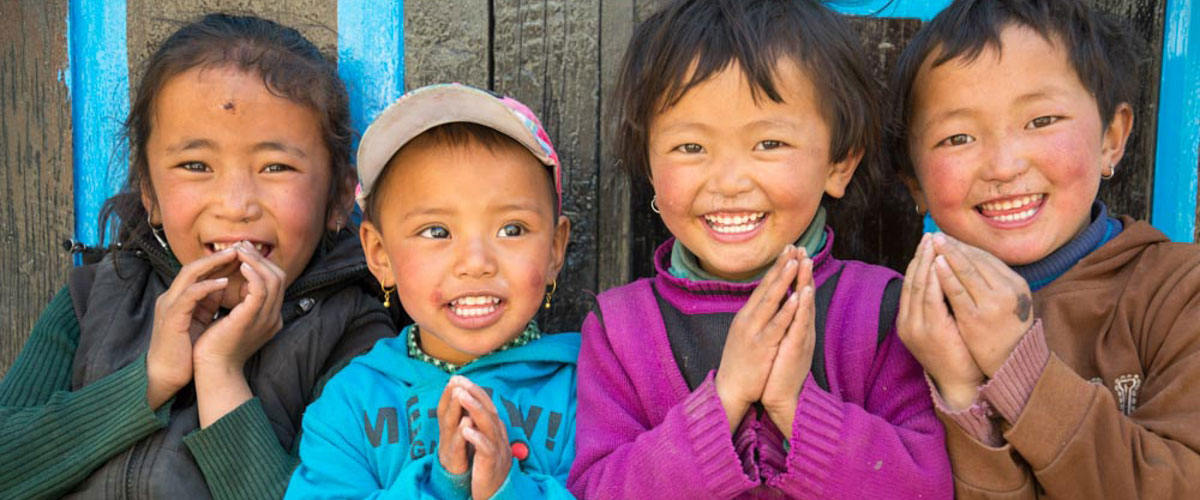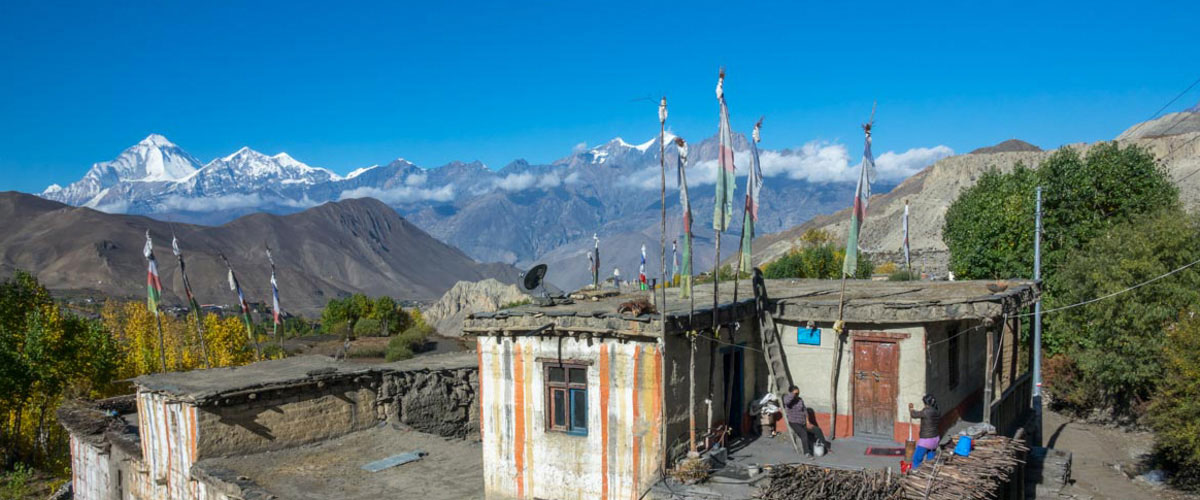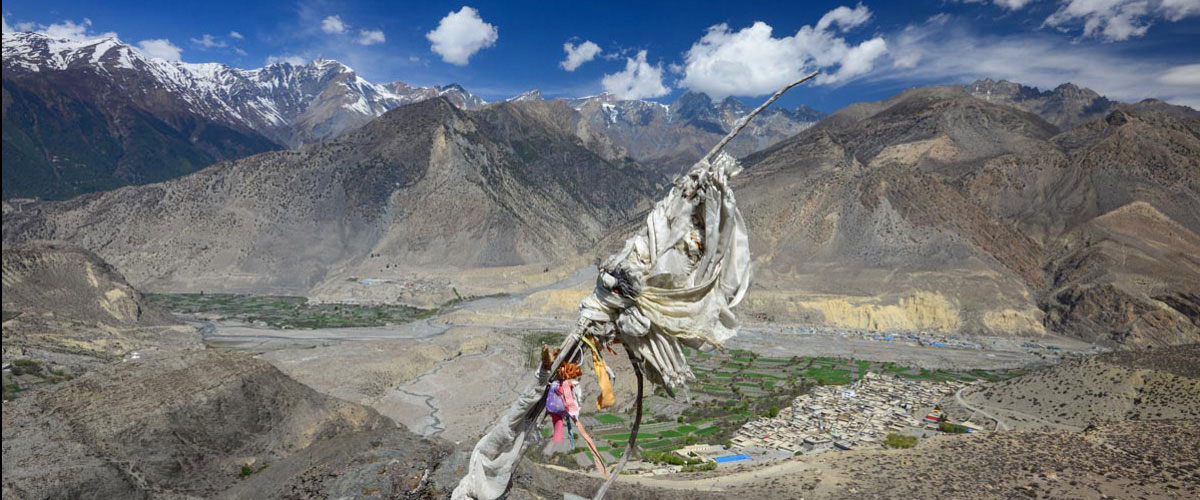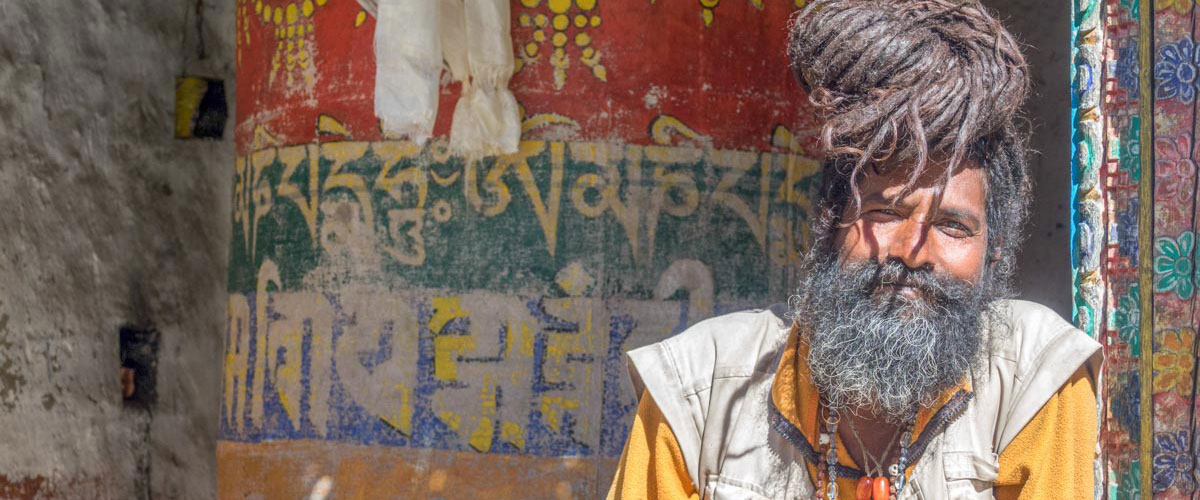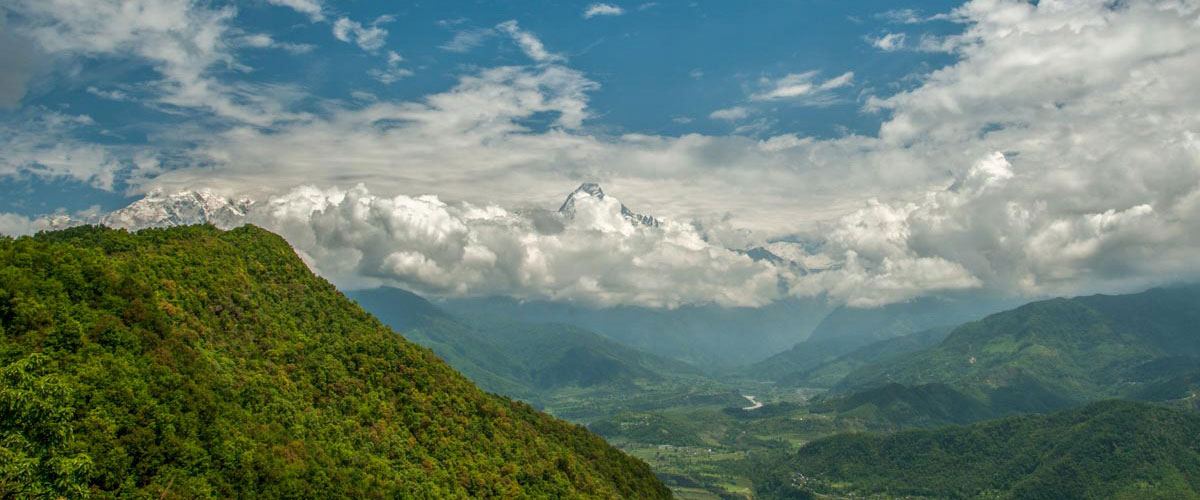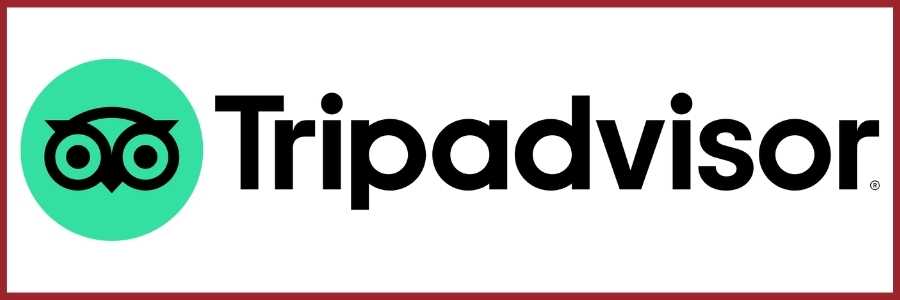Annapurna Khopra Danda (Ridge) Lodge Trek
Annapurna & Dhaulagiri Panorama Treks
Nepal Himalayan Trekking
Annapurna Khopra Danda & Annapurna Dhaulagiri Panorama Trek
We start our Nepal hike in steamy Hindu villages, where water buffalos wallow in the rivers, colorful, sari-clad women sit and weave by thatched huts, and villagers perform ancient rituals to appease their local deities. The sub-tropical forests come alive with an immense variety of bird life, waterfalls thunder down from steep cliff sides and monkeys chatter from the tree-tops. Trekking higher into the green, terraced hills we wander through ancient, mossy Rhododendron forests to reach the cooler Buddhist and animistic middle hills, where chortens and prayer flags send prayers out to the gods and the Gurung and Magar inhabitants look more Tibetan than Nepali. Terraced fields and tropical fruit trees surround the neat, white-washed Gurung villages of the higher regions, leading the eye to vistas dominated by some of the Himalaya’s most majestic peaks. The Annapurna region is truly the heart of the Nepal Himalaya.
Accompanied by views of Annapurna South, Machhapuchhre, Hiunchuli and Lamjung Himal, we trek in the heart of the Annapurna circuit. From Deurali, the amazing mountain views begin, and we contour through traditional villages to reach the bustling Gurung villages of Landruk and Gandruk. At Poon Hill, near Ghorepani, we are treated to a 360-degree sunrise Himalayan panorama. Back down through golden, terraced villages dominated by Machhapuchhre, the ‘Fish Tailed’ mountain, we continue to hike through Ulleri to the end of the circuit at Naya Pul and drive to Pokhara.
The Khopra Ridge trek is a classic Nepal trek, enjoying the lodges and famed hospitality of the inhabitants of the Annapurna region, your gear is carried by porters, and you have a local guide to explain the various cultures, mountains, and sights along the route. Finishing back in Kathmandu, it’s been a wonderful journey through diverse regions and landscapes of one of the most spectacular regions of the Himalaya!
Chitwan National Park | Maruni Sanctuary Wildlife Safari
Maruni Sanctuary Lodge, owned and operated by the Kathmandu Guest House, is one of Chitwan’s original lodges. Chitwan National Park is home to the Bengal Tiger and Asian one-horned Rhino as well as a large variety of rare bird and wildlife, and a lovely national park surrounded by traditional Tharu villages. If you have an extra day on hand we will adjust so that you have time to sit on the breezy deck with a book, rent bikes to explore the traditional thatched hut Tharu villages, where water buffaloes laze under tropical skies. Or to continue with the river paddles, spotting more varieties of Kingfishers.
Royal Treatment | Pokhara + Kathmandu
Treat yourself to a truly luxurious holiday, staying at Temple Tree Resort + Spa or the Himalayan Front Resort in Pokhara, where you can spend the day at the infinity pool, having massages or indulging in various spa treatments. The Himalayan Front Resort is situated in Sarankot, and features some of the best Himalayan panoramas from the windows of your room. Temple Tree Resort + Spa is on Lakeside in town, close to shopping, paddling and restaurants, bars and cafes. Top of your trip in true style and luxury at Dwarika’s heritage hotel in Kathmandu, with options to spend additional days at Dwarika’s incredible Dhulikhel Resort.
Customize Your Journey
Explore historic Kathmandu’s World Heritage sites in style, indulge yourself with a spa day in balmy, lakeside Pokhara and enjoy some incredible trekking in the Annapurna region. Kamzang Journeys has crafted three price options for this trip, from traditional boutique to deluxe to cater to all types of travel.
We are happy to customize your journey to include more days in Kathmandu, Chitwan National Park or Pokhara.
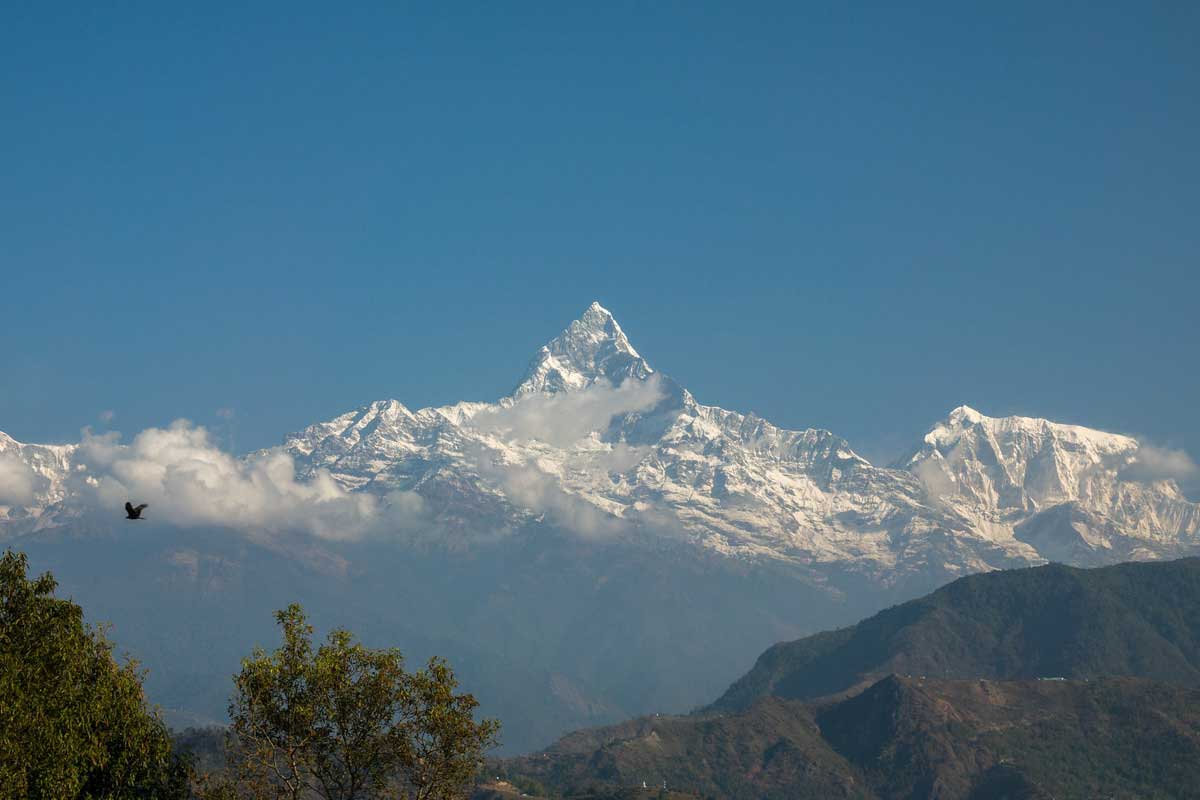
Trip
Annapurna Khopra Danda (Ridge) Lodge Trek | Annapurna & Dhaulagiri Panorama Treks – Nepal Himalaya Trekking
Day 1 – Arrive Kathmandu | Transfer Hotel
Day 2 – Kathmandu | World Heritage Sites
Day 3 – Fly Pokhara. Drive Nayapul + Trek Birethanti
Day 4 – Trek Ghandruk
Day 5 – Trek Tadapani
Day 6 – Trek Bayeli Kharka
Day 7 – Trek Khopra Ridge
Day 8 – Khopra Ridge | Exploration Day
Day 9 – Trek Swanta Village
Day 10 – Trek Mahare Danda
Day 11 – Trek Ulleri
Day 12 – Trek Nayapul. Drive Pokhara
Day 13 – Fly Kathmandu | Transfer Hotel
Day 14 – Trip Ends
Khopra Ridge Trek – Shorter Trip
Day 1 – Arrive Kathmandu | Transfer Hotel
Day 2 – Kathmandu | World Heritage Sites
Day 3 – Fly Pokhara + Drive Nayapul + Trek Gandruk
Day 4 – Trek Ghorepani
Day 5 – Trek Khopra Dande Ridge
Day 6 – Khopra Danda | Day Hike
Day 7 – Trek Tatopani
Day 8 – Trek Beni + Drive Pokhara
Day 9 – Fly Kathmandu | Transfer Hotel
Day 10 – Trip Ends
Kim & Lhakpa’s Personally Guided Trips
Featured Journeys
Client Highlights & Reviews
Travelers’ Comments
Chitwan + Bardia Luxury Wildlife Safaris | Tiger Tops Lodges
Tiger Tops Wildlife Safaris | Chitwan Tharu Lodge + Bardia Karnali Lodge
Chitwan Wildlife Safari | Maruni Sanctuary Lodge
Amazing Nepal Heritage Tour | Kathmandu, Chitwan, Bandipur & Pokhara
Annapurna Foothills Luxury Trek
Annapurna Foothills Luxury Trek
Incredible Nepal + Annapurna Foothills Luxury Trek | Kathmandu, Pokhara, Bandipur + Chitwan
Incredible Nepal | Kathmandu, Pokhara, Trek + Chitwan Maruni Lodge
Nepal Modules
Nepal & Kathmandu Modules | Customize Your Trip!
Itinerary
Annapurna Khopra Danda (Ridge) Lodge Trek | Annapurna & Dhaulagiri Panorama Treks – Nepal Himalaya Trekking
Day 1 – Arrive Kathmandu 1340m (4395′) | Transfer Kathmandu Guest House
Welcome to Nepal! You will be met at Tribhuvan International Airport by a representative from Kamzang Journeys or Khumbu Adventures (our partners in Kathmandu) Doma, Lhakpa and Nuru Sherpa). Look for a sign with your name on it as you leave the arrival area. We strongly suggest purchasing a NTC (Nepal Telecom) SIM card as you leave the airport if you have an unlocked phone. It’s very useful for data in the remote regions of Nepal. We will transfer you to the Kathmandu Guest House (or see Great Stays tab for luxury, boutique, and other hotel options in the Kathmandu Valley) where your room has been booked for you. Drink plenty of water to hydrate after your flight, and enjoy your first evening in Kathmandu …
We’ll need your travel medical insurance, a copy of your passport and Nepali visa, and one (or more) visa-sized photos (inquire if we need for your trek); please have them ready to give to Lhakpa, Doma or Nuru. And please ask if you need your gear checked, or have shopping or sightseeing questions!
Thamel is a myriad of shops of all imaginable varieties, bakeries, cafes, restaurants, bars, hotels, spas, climbing walls, colorful banners and signs, and eccentrically clad backpackers. Enjoy dinner at Roadhouse Cafe, New Orleans, Yin & Yang, Third Eye, or one of Thamel’s other restaurants … (B)
Day 2 – Kathmandu
Enjoy a free day exploring Kathmandu’s many World Heritage sites or embark on a tour of the beautiful Kathmandu valley, surrounded by Himalayan snow peaks (See Kathmandu Valley Tours for optional tours with a qualified guide, car, and entrance fees included). Or just relax at the hotel, visit the spa, have a massage, wander Kathmandu’s fascinating streets, pop into neighborhood Hindu temples and Newari-styled courtyards, join in on koras of the Buddhist temples. (B)
Cafe Caravan & Dolpo Gallery
Dolpo Artist Tenzin Norbu creates wonderful Dolpo paintings, the prints (and some originals) are available from our Cafe Caravan at Boudhanath Stupa, housed in one of Boudha’s original historic buildings, decorated in a bright, Tibetan style and overlooking the magnificent stupa!
Sightseeing in Kathmandu
Nuru Wangdi Sherpa (Khumbu Adventures & Café Caravan) has his Kathmandu guide license and a large SUV vehicle, and can arrange any sightseeing you might want to do in Kathmandu and the Kathmandu valley. He is often available for guiding your excursions as well. Mobile + WhatsApp: +977 9803633783 (WhatsApp)
Massage in Kathmandu (Ramji of Relieving Hands)
Ramji is a blind masseur trained by Seeing Hands in Kathmandu, who now offers wonderful at home (or hotel) massages, with his own massage table and oil. He is truly a master masseur, a real healer and VERY highly recommended. His prices are extremely reasonable. Let us know if you want help to arrange a massage.
Relieving Hands by Ramji
Kathmandu | World Heritage Sightseeing Tours – Pashupatinath, Boudhanath, Durbar Square & Swayambunath
Kathmandu is filled with World Heritage sites and sacred destinations, crowded with traditional neighborhoods and colorful festivals. Spend a few days exploring Nepal’s exotic capital and the history-laden Kathmandu valley. We can arrange sightseeing guides and vehicles as required. See Kathmandu Heritage & Happenings for more details.
We recommend beginning with Pashupatinath in the early morning and moving on to Boudhanath mid-morning. Hindu Pashupatinath on the sacred Bagmati river and its sacred temple complex is one of Nepal’s most important sites, a powerful cremation site, and Nepal’s most important Hindu temple. Here, monkeys run up and down the steps of the burning ghats, and trident-bearing saddhus draped in burnt-orange and saffron sit serenely meditating when they’re not posing for photos-for-rupees. Local guides can explain the significance of the complicated ceremonies. Please be respectful when taking photos.
Boudhanath, in the midst of traditional monasteries (gonpas in Tibetan) and hung with long strings of multi-colored prayer flags, attracts Sherpas, Tibetans, and tourists alike for daily circumambulations (koras) of the iconic stupa. The striking Buddha eyes of Boudhanath Stupa watch over a lively and colorful Tibetan community and attract pilgrims from all over the Himalayan Buddhist realm. There are wonderful spots for lunch at Boudhanath (Roadhouse Cafe has wood-oven pizzas and a breathtaking view of the stupa and colorful Nepals circling it), and it’s a good place to learn the technique of thanka painting and purchase a thanka (Buddhist mural). See also Bhaktapur for more options for shopping for thankas.
Wander through the many temples, pagodas, courtyards, and the museum at Kathmandu Durbar Square, a timeless gathering spot and a UNESCO World Heritage site. Kathmandu Durbar Square, including the old royal palace, is Kathmandu’s ‘Palace Square’, a showcase for the world-renowned artisans and craftsmen of Kathmandu and a synthesis of Hindu and Buddhist palaces, temples, stupas, and statues. The Malla and Shah kings ruled over the Kathmandu Valley during the centuries of the building of the layers of this Durbar Square. Along with their opulent palaces, the square surrounds numerous courtyards and temples, all works of art with intricate and often erotic carvings. Kathmandu Durbar Square is known as Hanuman Dhoka Durbar Square, a name derived from a statue of Hanuman, the monkey devotee of Lord Ram, at the entrance of the palace. The social, religious and urban focal point of the city, Durbar Square is often the site of festivals, marriages, and other ceremonies such as Teej. Some important structures are Hanuman Dhoka Palace, Kumari Ghar (Abode of the Living Goddess), Taleju Temple, built between the 12th and 18th centuries, the 17th century stone inscription set into the wall of the palace with writings in 15 languages.
In the evening (take the interesting back streets from Durbar Square) climb the many steps to the gilded Swayambhunath stupa (known as the monkey temple) which rises from the Kathmandu valley floor at 1420 meters and is one of the holiest Buddhist sites in Nepal. Swayambunath, the ‘self-created’ stupa, was founded over 2000 years ago at a time when the Kathmandu valley was filled by a large lake, with a single lotus in the center. Mythology says that Manjusri, a bodhisattva, drained the lake with one cut of his sword and the lotus flower was transformed into the stupa. From its commanding views of Kathmandu, circumambulate Swayambunath’s white-washed stupa, painted with distinctive Buddha eyes, the complex a unique synthesis of Buddhism and Hinduism. Another interesting time to visit Swayambunath is in the mornings when Nepalis visit the temple dedicated to the God of Smallpox with colorful offerings for the goddess.
Stop to photograph reflections in Kathmandu’s many pokharis or ponds, including the beautiful Rani Pokhari (queen’s bath) near New Road, and the Naga Pokhari (pond of the snake gods of the underworld) just beyond the palace gates. The many bathing ghats, square enclosures with steps leading down to water spouts, often decorated with naga heads, are also interesting and colorful gathering spots.
Day 3 – Fly Pokhara 830m. Drive Phedi or Kande. Trek Photana 1890m or Bichok Deurali 2130m
Transfer to the domestic airport for the scenic flight to semi-tropical Pokhara. Nepal’s second largest ‘city’ is 198 kilometers west of Kathmandu; en route you will look down on rivers flowing towards the Terai from the Himalaya and Tibet, over terraced villages and green hills with the Ganesh, Langtang, Manaslu and Annapurna ranges in the distance, to balmy, sub-tropical Pokhara.
One in Pokhara a private vehicle will transfer you, with your guide and porter for the trek, to Phedi or Kande, from where you will start the trek into the wonderful, green central Annapurna region. You’ll hike straight up stone steps through a dense forest first thing in the morning, afterwards contouring less steeply along paddy fields, past slate-roof houses and a few small tea-houses. About three hours later you will reach the picturesque Gurung village of Dhampus.
Continue to climb through lovely rhododendron forests and you soon reach the small hamlet of Pothana, a possible stopping point for the night. The views start to open up as we near the plateau of lower Deurali, with quaint, Himalayan villages opening up below us. Continuing on along a partially stone-paved trail, we soon reach Bhichok Deurali. You’ll spend the night at the last lodge in the village, and feast on views of Annapurna South, Machhapuchhre (Fish Tail Peak) and Dhaulagiri in the evening. (3-4 hrs trek)
Luxury Treks stay at Basanta Lodge in Dhampus (+$75)
Panoramic views of the Phedi and Mardi Valleys can be enjoyed at 4,920 feet from Basanta Lodge in Dhampus. Nearby activities include nature walks through thick forests of bamboo, conifer and rhododendron, as well as farming demonstrations on the steep hillside terraces.
Khopra Ridge Trek
Day 1 – Arrive Kathmandu
Day 2 – Kathmandu | World Heritage Sites
Day 3 – Fly Pokhara + Drive Nayapul + Trek Birethanti
Day 4 – Trek Ghandruk
Day 5 – Trek Tadapani (2,590m)
Day 6 – Trek Bayeli Kharka (3,420m)
Day 7 – Trek Khopra Ridge (3,660m)
Day 8 – Khopra
Day 9 – Trek Swanta Village (2,200m)
Day 10 – Trek Mahare Danda (3,330m)
Day 11 – Trek Ulleri (2,050m)
Day 12 – Trek Nayapul. Drive to Pokhara
Day 13 – Fly Kathmandu
Day 14 – Depart
Khopra Ridge Trek – Shorter Trip
Day 1 – Arrive Kathmandu | Transfer Hotel
Day 2 – Kathmandu | World Heritage Sites
Day 3 – Fly Pokhara + Drive Nayapul + Trek Gandruk
Day 4 – Trek Ghorepani
Day 5 – Trek Khopra Dande Ridge
Day 6 – Khopra Danda | Day Hike
Day 7 – Trek Tatopani
Day 8 – Trek Beni + Drive Pokhara
Day 9 – Fly Kathmandu | Transfer Hotel
Day 10 – Trip Ends
Correct Itinerary Coming …
Day 5 – Trek Gandruk 1940m
Another wonderful day of trekking, starting with a gentle wander through the extensive village of Landruk, endlessly interesting. Watch the local Gurung women weaving with their wooden looms, drying vegetables to make a spicy ‘achar’, sorting lentils for dal or involved in the morning’s washing at the village taps. Once through Landruk, we have a a steep descent through open forest and paddock land on a partially stone trail. Once down, we cross the Modi Khola on a steel bridge to Khumi (1350m), from where we start our steep climb to Gandruk, the last of it on stone steps. Take advantage of the ‘chautara’ or stone resting spots, along the way. The slope is steep and it’s a long climb, but once up you’ll be rewarded with a large and bustling Gurung village contouring around the expanse of terraced hillside. Gandruk is perhaps the largest and most prosperous village in the region, with two interesting museums, local restaurants featuring their unique Gurung cuisine and many guest houses. We stay at a lovely garden guest house and will hike up a bit along the cobbled steps for sunset views in the evening. Annapurna South and Hiunchuli dominate the horizon while the views of Macchupucchre have changed so that it looks more like its translation, a fish tail. Annapurna I and Gangapurna are just visible in the distance if the weather is clear.
Spend the afternoon exploring this fascinating and bustling Gurung village, a labyrinth of narrow alleyways, white-washed, slate-roofed houses with porches and traditionally-carved windows, water buffalos in thatched huts and open slate patios. If time permits you could hike up to the Hindu temple a ways above the village. There is lots to keep one busy in this picturesque village, and the villagers are friendly, always ready for a laugh or a chat. (3-4 hrs trek)
NOTE: Luxury treks will stay at the beautiful Himalayan Lodge in Gandruk (+$75)
Himalaya Lodge, located at 6,560 feet, overlooks the slate-roofed village of Ghandruk, once a popular recruitment location for the Gurkha soldier regiments. Villagers today craft traditional hand-woven rugs as they have for generations, and also participate in ecological endeavors via the Annapurna Conservation Area Project.
Option | Extra day in Gandruk
We’re happy to book you an extra night in the beautiful Himalayan village of Gandruk if you have extra time. The idyllic village deserves another full day to hike, wander the alleyways, photograph the incredible views, sample the traditional cuisine and chat with the welcoming locals. (+$105 or +$180 for Himalayan Lodge)
Day 6 – Trek Tadapani 2630m
Another balmy start as you head for Tadapani, the village which translates as ‘far water’. Tadapani is perched on a plateau overlooking the peaks of the Annapurna region. To reach it we trek out of Gandruk for a few kilometers, cross the Kyunri Khola and climb to Baisi Kharka (kharka means ‘grazing field’ in Nepali, a commonly used word in the trekking world and baisi translates as ‘buffalo’) at 2470 meters. From here, trek through a lovely, open forest filled with chattering langur monkeys and birds, ascending all the while; a wonderful hike. Finally at Tadapani, your highest sleeping point yet, we relax with a cup of chai in hand as the clouds swirl around us, revealing breathtaking views of Machhapuchhre soaring above us. A sublime sight; the snow peaks in front of the lodge are Annapurna South, Hiunchuli, Annapurna III, Machhapuchhre, Annapurna II, and Lamjung Himal, and much of your trek is visible in the valleys below. (3 1/2 hrs)
Day 7 – Trek Ghorepani 2920m
We have another steep and slightly longer day of trekking today, starting with an ascent through dense, damp forests, the tree-tops swaying under the weight of the langur monkeys. There are several clearings in the forest, many of them with local tea-houses offering basic fare. Soon we reach Banthanti (2650m), a hamlet of small thatched dwellings, buffalos and tea-houses. Crossing the small stream at the end of the settlement, our steep climb begins. Again, there are many chautaras en route, so take advantage of these to drink some water, have a rest and admire the views. The trail can be slippery if its muddy, so watch your step as you climb. Higher up, the trail crosses several small streams and by small huts until we finally reach the small settlement of Deurali (3050m), where Tibetans own the souvenir stalls. Finally, we have a well-deserved descent through a forest of birch, bamboo and rhododendron; about two kilometers more, contouring around green hillsides, and we reach Ghorepani, our destination for the day.
Ghorepani, which means ‘horse water’, is a busy trekking village with a real Himalayan ambiance. We’ll get a room in the newer, upper section of the village and have a wander around town in the afternoon. There are bookshops and lots of local (or Kathmandu-made) souvenirs to buy, plenty to keep you busy for a few hours. Don’t miss the sublime alpenglow on the Himalayan peaks in the evening, especially as at sunrise from Poon Hill in the morning the sun is behind many of the peaks. (6 hrs)
Day 8 – Trek Poon Hill 3210m. Trek Ulleri 1960m or Hile 1430m
You’ll be up before sunrise for the spectacular panorama from Poon Hill, an hour’s steep climb above Ghorepani. It’s a popular spot, so you will share the views with other trekkers and their Nepali guides. Make sure your camera has full batteries; this is a once-in-a-lifetime Himalayan view dominated by Annapurna South (7219m), Annapurna I (8091m), Machhapuchhre (6993m), Hiunchuli (6441m) and Lamjung Himal (6931m) as well as the Ganesh Himal range, Dhaulagiri (8167m), Niligiri and Tukuche Peak (6920m). Don’t leave the viewpoint to quickly as the mountains emerge into the deep blues of the morning sky later in the morning. Perhaps bring a pastry from one of the bakeries with you and relax with this breath-taking sight.
Heading down for breakfast back in Ghorepani, you’ll later hike back down steep steps through a forest of rhododendron to tiny Nayathanti village, soon afterwards crossing a stream to reach the settlement of Banthanti. Now out of the forest, you hike through a bit of terraced village land to reach scenic Ulleri, where we stay at a lodge for the night. Ulleri is a Magar village with many lodges as it is a popular stop on the central Annapurna route. You may opt to continue further down the steep stone steps to Hile, another 1 1/2 to 2 hours away. (5 1/2-7 hrs)
Day 9 – Trek Naya Pul 1070m. Drive Pokhara
Our last day of trekking, and another steep descent down slate steps to Tikhedunga (1540m) and perhaps Hile, with beautiful vistas the entire way. Continuing down the contouring stone steps, you pass Sudame and then Matathanti before finally reaching Birethanti (1020m), at the confluence of the Modi Khola and the Bhurungdi Khola, where we will check out of the Annapurna Conservation Area. Less than half an hour away along a dirt-road is the bridge at Naya Pul (‘new bridge’ in Nepali), where you’ll meet your private vehicle (or the guide will get a taxi) to take you back to the hotel in Pokhara. (2 1/2 hrs)
Day 10 – Pokhara
There is endless opportunity to spend extra time in Pokhara, so at least one day in this balmy town is a must. Options including a stroll part-way around Phewa Lake, paragliding or zip-lining from Sarankot, paddling on the lake, a morning hike up to Shanti Stupa via a short canoe trip or a day of shopping for the creative locally-produced crafts along Lakeside.
Optional Chitwan Wildlife Safari | Chitwan National Park Wildlife Safari & Tharu Villages
Day 11 – Fly Kathmandu
After a bountiful buffet breakfast, you board the morning flight back to Kathmandu (with options to take an afternoon flight or stay extra days in Pokhara). You have the afternoon in Kathmandu for shopping, some sun in the garden of the Kathmandu Guest House or your luxury or boutique hotel, shopping or perhaps a visit to Boudhanath for some ‘koras’ to give thanks for the safe journey in the mountains. This is also the extra day in case of cancelled flights out of Pokhara.
Kathmandu | Optional Sightseeing Tour Bhaktapur
One more day in Kathmandu, with a sightseeing excursion by private vehicle to Bhaktapur. Bhaktapur which translates as ‘Place of Devotees’ and is also known as Bhadgaon, is an ancient Newar city approximately 15 kilometers east of the Kathmandu Valley. Bhaktapur is one of three ancient capitals of the Kathmandu valley, the capital of the Newar Kingdom and a city of artisans and craftspeople famous for its art and architecture: intricate carvings, sculptures, paintings, thankas, pottery, statues and temples, or pagodas. Bhaktapur has a well-preserved ‘durbar square’, or palace square, and has been named a World Heritage site by UNESCO because of its incredible temples, pagodas, wood carvings, stone carvings and metalwork. Bhaktapur is also famous for its yogurt, called curd in Asia, a taste which hasn’t been duplicated anywhere.
Spend a full day exploring Bhaktapur and its rich cultural heritage, where a majority of enthnic Newaris live in traditional ways, and life seems to stand still. There are many great restaurants and cafes to rejuvenate, and it’s possibly the best spot in Kathmandu for purchasing a thanka after watching the technique, as well as shopping for endless other locally produced crafts. Bhaktapur is home to countless local festivals, so if you are lucky and arrive on a festival day, enjoy the timeless and colorful events unfold.
Kathmandu World Heritage Sightseeing Tour | Bhaktapur (+$100)
Kathmandu | Optional Patan Sightseeing Tour
Visit the third of Kathmandu’s ancient capitals, known as ‘The City of Fine Arts’, best if you have an extra day in hand as Patan is also rich in cultural heritage, has many lovely roof-top cafes for lunch and world-class museums. Some of the highlights of Patan are its Durbar Square, the Krishna Temple within the palace complex of Patan (entirely made of stone, with 21 distinctive spires), and Hiranya Varna Mahavir, or the Golden Buddha Temple.
Kathmandu World Heritage Sightseeing Tour | Patan (+$50)
Option | Everest Sightseeing Flight
An hour long extravaganza of the world’s 8000 meter peaks, including airport transfers. (+$270)
Option | Extra Days at Shivapuri Heights Cottages
A wonderful get away 20 km north of Kathmandu, Shivapuri Heights Cottages are stylishly designed and personal cottages built around a ‘common house’, where you can breakfast overlooking the stunningly beautiful Kathmandu valley. Massages available on request. (+$)
Option | Cycling Trip in Kathmandu Valley
Many options for day trips, or extended trips, in the Kathmandu Valley. We can customize a cycling trip for you in partnership with one of our knowledgeable partners in Kathmandu. (+$)
Day 12 – Depart
We take you to the airport for your flight home. Namaste!
Date & Price
Dates
Custom Departures
12 Days
+ Chitwan Wildlife Safari
14 Days
Traditional Trek Price – $1880
(Kathmandu Guest House, Lake View Resort)
Single Supplement $250
Boutique Trek Price – $2080
(Kantipur Temple House, Shangri La Village Pokhara)
Single Supplement $600
Super Luxury Trek Price – $2880
(Dwarika’s Heritage Deluxe Rooms, Temple Tree Resort + Spa)
Single Supplement $800
Chitwan Options
Chitwan National Park Wildlife Safari & Tharu Villages
Super Deluxe Dwarika’s++ (+1050 Single – +$600 Double)
Extra Trek Day Gandruk (+105)
Extra Day Chitwan (+$125)
Everest Sightseeing Flight (+$250)
Extension Shivapuri Heights Cottage (+75 Night Depending on Room)
Cycling Trip in Kathmandu Valley (+Trip Price)
+ 1905 or Yak & Yeti (Kathmandu)
+ Temple Tree Resort + Spa (Pokhara)
+ Hotel Single Supplement – $300
Kathmandu Guest House Single & Double Upgrades
+ Deluxe Upgrade Kathmandu Guest House (3 Nights) – $135
+ Suite Upgrade Kathmandu Guest House (3 Nights) – $225
Kathmandu Guest House | Extra Nights Room Price
Includes Breakfast & Taxes
Standard Single – $55
Standard Double – $65
Deluxe Single – $100
Deluxe Double – $110
Suite Single – $130
Suite Double – $140
Includes
- Kathmandu Guest House, Kantipur Temple House or Dwarika’s in Kathmandu
- Lake View Resort, Shangri La Resort or Temple Tree Resort in Pokhara
- Domestic Flights on Yeti Airlines
- Departure tax
- Airport pick-ups & drops
- ACAP permit
- TIMS card
- Private car to Chitwan
- Kamzang Lodge Trekking: All meals from lodge menu, herbal teas and French press coffee, double rooms at lodges, small medical kit, porters & Nepali guide
Excludes
- International flights
- Travel or travel medical insurance
- Nepal visa
- Meals in Kathmandu (while not on trek)
- Helicopter rescue cost
- Equipment rental
- Alcohol & soft drinks
- Showers & hot water bottles
- Laundry
- Tipping & other items of a personal nature
Tips & Extra Cash
Allow approx $200 for meals (while not on trek), shopping & drinks (on trek). We recommend $150 per trekker divided between the staff for tips.
Map
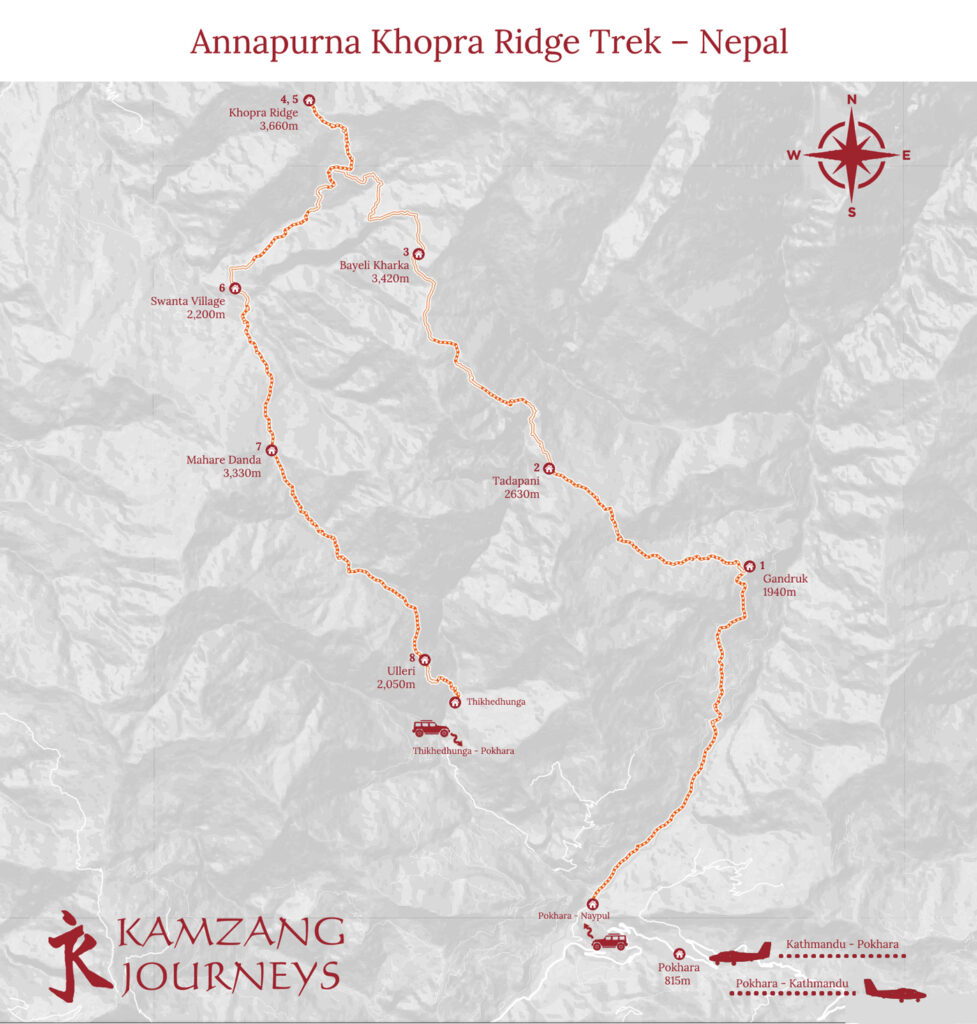
Highlights & Reviews
Kamzang Journeys Reviews
Client Comments
Kim arranged a solo trek for me at very short notice in November 2013 – and did it even whilst most of them were leading another trek in Mustang! They made the complex easy. From a wonderful guide to helping me arrange evacuation when I got sick, I was always in knowledeable, kind, efficient hands. I recommend Kamzang Journeys without reservation and I’ll be using them when I return to Nepal in September 2014!
– Nick A (UK), Private Everest Trek 2013
Tsering Sherpa is marvelous, extremely responsible, serious, devoted, very thoughtful, discreet and very pleasant to trek with. He is very helpful, well travelled, speaks good English, is well-mannered and has a good experience as a mountaineer and a climber. He is very powerful, strong and quick, and smiles a lot! He seems to know everybody on the trail, is active in his community and is respected by other Sherpas. On trek he was a good counsellor on food, and of course respectful of tradition and of the Tibetan Buddhist faith. With him we felt very secure as he knows the trail and all the short cuts.
– Nan & Odette (France), Private Everest Base Camp Trek 2014
Viney was my private guide to trek to Everest base camp in October 2013. I felt very secure with him the entire time. He was always attentive to my wellbeing from the time we started in x (kim pls fill in) where we ended up slogging through rainfall and mud due to the cyclone left over from India, all the way through to the end of our trip in Lukla. I could count on him without a doubt every day of the entire 3 weeks we spent together. Thanks to Viney for an excellent trek!
– Lori C (USA), Private Everest High Passes Trek 2014
Last May I spent almost three weeks hiking with Mingma in the Khumbu region of Nepal and we explored the Gokyo lakes, Gokyo valley and we climbed Gokyo Ri. Mingma is an experienced mountain-guide, knows all the summits in the region, the Sherpas and routes. He is responsive of the challenges, strong and kind, but he is very calm in case of difficult situations. While we walked together, he was attentive and he always tried to accommodate my phyisical condition and my spiritual eagerness. We spent wonderful time together and I immensely enjoyed every moment of the trek. I am planning to walk with him again in 2015!
– Kati K (Hungary), Private Gokyo Lakes Trek 2014
Tashi was the perfect guide for me. I was going solo, and looking mostly for solitude; Tashi’s temperament was the perfect match for mine. When he had something to say, it seemed eerily to come right when I was about to ask him a question about the very thing he started to speak about! He has a real passion for the natural world he lives in and for the Sherpa people and their traditions, too. I ended up falling ill with something and here again Tashi was the perfect guide – helpful but not smothering or overly-solicitous. I will be back, and with my family and I’m certain to request that Tashi accompanies us when we return.
– Nick A-H (UK), Private Everest Base Camp Trek 2013
Thanks for looking after my friends Ian & Adam so well! They were really pleased and very impressed with the arrangements made by Kamzang Journeys and particularly pleased with the guide, Karma, who did a wonderful job of looking after them on their trek. Everything went to their satisfaction and it exceeded their expectations. He’s now got a taste of Nepal and thinking about doing another trek there sometime!
– Viv D, friend of Paul & Patrick, Private Annapurna Peaks & Villages, Helambu Trek 2014
I have traveled the world and I have never been as cared for as I was in my trek in Nepal. Karma was beyond attentive and professional. He has become family. The very best of Nepal and mankind can be found in this young man.
– Dave M, Annapurna Peaks & Villages 2013
Client Highlights
Travelers’ Comments
Trip Highlights
- Kathmandu World Heritage Sites
- Lower Annapurnas Trek
- Spectacular Himalayan Panoramas + Traditional Villages
- Chitwan National Park + Wildlife Safaris
- The Old Inn at Bandipur
- Pokhara + Phewa Lake
- Opportunities for Spa + Massage
- Optional Everest Sightseeing Flight
Kim Bannister Photo Gallery | Trip + Trek Photos
Kim Bannister Photography
Travel Reading | Enhance Your Trip!
Travel Books
Contact & Details
Kamzang Journeys Contact
Kim Bannister
kim@kamzang.com
kamzangkim@gmail.com
Mobile: +(977) 9803414745 (WhatsApp), 9863196743
On-Trek Satellite Phone: +88216 21277980 (Nepal)
Kathmandu Contact
Khumbu Adventures
hiking.guide@gmail.com
Lhakpa Dorji Sherpa Mobile: +(977) 9841235461, 9705235461
Doma Sherpa Mobile: +(977) 9841510833, 9705510833
Nuru Wangdi Sherpa Mobile: +977 9803633783 (WhatsApp)
Follow Us on Facebook
Kamzang Journeys Facebook
Kathmandu Arrival Hotel
Kathmandu Guest House
Nepal Tourist Visas
You can get your Nepal visa at TIA International Airport (or any land border) when you arrive in Nepal, or before you leave home at a Nepali Embassy or Consulate. When you arrive at immigration in Kathmandu, scan your passport at the visa machines (no photo needed) or produce your online, printed visa-on-arrival form, pay the visa fee, and go to the appropriate immigration line.
15 Days – $30
30 Days – $50
90 Days – $125
Tourist Visa Extension (15 days) – $45 (+$3 Additional Day))
Nepal Visa
Nepal Visa Information
Kathmandu Guest House
Ward: 16, Street name: Saatghumti, Area: Thamel, District: Bagmati, City: Kathmandu, Zone: Bagmati, Phone: +977 14700004
Health Information
Nepal Health Information
CDC
We also recommend bringing probiotics with you to help prevent infections while on trek. Doctor’s recommendation!
Travel Medical Insurance
Required for your own safety. We carry a copy of your insurance with all contact, personal and policy information with us on the trek and our office in Kathmandu keeps a copy. Note that we almost always trek over 4000 meters (13,000′) and that we don’t do any technical climbing with ropes, ice axes or crampons.
Global Rescue Rescue Services
We recommend (but don’t require) that our trekkers sign up for Global Rescue services as a supplement to your travel medical insurance. You can book this directly through our Kamzang Journeys site.
Global Rescue
Medical On-Trek
Please do have a full check-up before leaving home, and inform us of any medical issues. This is for YOUR OWN safety. Your guides bring a small medical kit, but you’ll want your own medications with you.
DO bring all prescription medications and rehydration powders-electrolytes. We advise bringing your own Diamox, Ciprofloxin, Azithromycin + Augmentin. We do have all of these with us, but the Western versions are generally more reliable than the Indian equivalents. See Gear List for a full list of recommended medications for the trek.
Travel Reading | Enhance Your Trip!
Travel Books
Not Enough of Nepal?
We highly suggest taking advantage of your trip to Nepal, adding on excursions into the Kathmandu Valley, Pokhara, Bandipur, Gorkha, the Annapurna Foothills, and Chitwan and Bardia National Park. Enjoy heritage tours, mountain biking, Kathmandu valley hiking, Himalayan panoramas (and a hike down) from the Chandragiri Cable Car, whitewater rafting, yoga and meditation courses, Nepali cooking classes, Buddhist or Hindu retreats, and much more. There are many wonderful, boutique, luxury, and heritage lodges in the Kathmandu Valley, and many options for world heritage sightseeing tours, bicycle trips, hikes, and craft-cuisine tours. Nepal boasts world-class restaurants, chic cafes, timeless alleyways to wander through, countless Hindu and Buddhist festivals, and lots of great shopping.
Don’t miss an Everest sightseeing flight or epic helicopter tour, sightseeing trips to Bhaktapur, Patan, and Panauti (Kathmandu Valley’s other historic and/or capital cities), a weekend at Shivapuri Heights Resort or Dwarikas in Kathmandu, a night at the Fort Hotel in Nagarkot for sunrise and sunset Himalayan panoramas, a spa and wellness getaway at the ultra-luxurious Dwarikas Dhulikhel Resort and visits to ancient temple and monastery complexes such as Namo Buddha, Changu Narayan, and Dakshinkali. Spend a night at The Old Inn in Bandipur or Three Mountain Lodge en route to Pokhara, or The Famous Farm in Nuwakot, and get to know Nepal’s Newar heritage.
Enjoy a luxury 3-6 day trek in the Annapurna Foothills, staying in the wonderful Ker & Downey luxury lodges. Relax in heritage style at Temple Tree Resort in Pokhara for some pampering at the spa and infinity pool, try out paragliding, zip-lining, and enjoy a morning of boating on the lake and the hike to Shanti Stupa. Once refreshed, drive to Chitwan National Park, spending 2 or 3 nights at Maruni Sanctuary Resort or Tiger Tops Tharu Lodge for wildlife and bird spotting, river trips, and safaris in style. Tiger Tops also owns Karnali Lodge at Bardia National Park, reached by flight from Kathmandu, and there are nearby archeological sights to visit nearby.
Nepal Modules
Nepal & Kathmandu Modules | Customize Your Trip!
Notes on Itinerary
Although we try to follow our trek itinerary, it is ONLY a guideline based on years of experience trekking in many Himalayan regions. At times local trail, river or weather conditions may make a deviation necessary; rivers may be impassible, snow blocks passes, and landslides wipe out trails. The trekking itinerary and campsites may also vary slightly depending on the group’s acclimatization rate or sickness, or improved campsites and lodges.
The Himalaya are our passion, and we take our trekking and cycling trips seriously. Although everyone is here on vacation, please come with a dollop of patience and compassion added to your sense of adventure …
Arrival Kathmandu
Arrival in Kathmandu
You will be met at the airport by a representative from Khumbu Adventures (see Contact & Details tab). Look for a sign with your name on it as you leave the airport. You will be transferred to the Kathmandu Guest House where your rooms have been pre-booked … Please hydrate!
Nepal Tourist Visas
You can get your Nepal visa at TIA International Airport (or any land border) when you arrive in Nepal, or before you leave home at a Nepali Embassy or Consulate. When you arrive at immigration in Kathmandu, scan your passport at the visa machines (no photo needed) or produce your online, printed visa-on-arrival form, pay the visa fee, and go to the appropriate immigration line.
15 Days – $30
30 Days – $50
90 Days – $125
Tourist Visa Extension (15 days) – $45 (+$3 Additional Day))
Nepal Visa
Nepal Visa Information
Kathmandu Guest House
Ward: 16, Street name: Saatghumti, Area: Thamel, District: Bagmati, City: Kathmandu, Zone: Bagmati, Phone: +977 14700004
Arrival Hotel
Kathmandu Guest House
International Medical Center Kathmandu
CIWEC
Nepal Temperatures + Clothing
See Gear Tab for trekking and cycling clothing, as well as medical supplies recommendations.
Kathmandu during the spring and autumn trekking seasons is usually quite warm (t-shirt, sandals, light pants or skirts) during the day, and gets chilly (light fleece or jacket) in the late afternoon and evenings. Nights can be cold enough for a sweater and/or jacket, or warm enough for t-shirts. Summer is hotter and wetter, and you’ll need a rain jacket and umbrella. The winter months (late Nov – March) are chilly in the mornings and evenings, cold enough that you might start the day in a down jacket, but often warming up enough to wear a t-shirt by mid-day. Nights get cold enough for a down jacket if you’re sitting outside, although many restaurants have heaters or fire pits. It never snows in Kathmandu. Keens, Chacos or other hiking sandals are great for wandering around Kathmandu, and for trekking in lower altitudes. Crocs are good to have for rooms, showers and at camp when trekking or cycling.
Trekking is a mixed bag of temperatures. LAYERS are the key as hot can change quickly to freezing crossing the passes and snowfalls are common. We often have some rain below 3000 meters in the spring and early autumn, and it can rain hard in the summer. Have a wide range of layer-able trekking clothes for summer to winter temperatures. Keep a lightweight down jacket or synthetic jacket with you at all times, available inexpensively in Kathmandu. A lightweight rain poncho and umbrella for trekking are recommended in the spring and summer seasons. Be prepared! See our ‘Gear’ tab for full details on gear, shoes, clothing, electronics, and meds for the trek.
There are lots of real gear shops (North Face, Mountain Hardwear, Marmot, Sherpa Gear, OR) and many ‘fake’ and Nepali-made shops in Kathmandu, so if you don’t think you have the right gear starting the trip, it is easy to pick up gear once in Kathmandu. We have sleeping bags to rent, duffel bags, camp towels and buffs to purchase, and you’ll get a FREE Kamzang Journeys t-shirt for the trip!
Dress conservatively in Kathmandu and on the trail as a rule. Shorts are okay if they aren’t too short, short mini skirts aren’t recommended. Sleeveless t-shirts are absolutely fine, but perhaps avoid skimpy tank tops on the trail. Super tight lycra and very skimpy doesn’t go over so well with village elders or remote villagers, and will generally limit your ability to have meaningful interactions with Nepali villagers. Many of the younger generation in Nepal wear modern Indian or Western-influenced clothes but remember that you haven’t signed up for a beach or surf vacation. Use your good judgment, and be an ambassador for western travelers! Please ask Kim or your guide if unsure about appropriate clothing, we’re always happy to advise.
Nepal Cultural Issues
Nepalis are very open and welcoming, but there are a few issues you should be aware of to make your stay in Nepal more fulfilling. Use your right hand to pass things, shake hands or do most anything. Left hands are somewhat taboo. Nepalis often place their left hand on the right forearm when passing things to others, a sign of respect. Best not to pat kids on heads, or point feet ahead of you at monasteries. Don’t walk over someone’s legs or feet, but put your hand down in front of you to signal them to pull their legs to the side. Take off shoes and hats when going into Buddhist monasteries and Hindu temples, don’t use flashes inside monasteries or temples if possible and be respectful when attending pujas (prayer ceremonies). You can talk and move around, all religious are very tolerant, but be aware of your level of voice and where you are walking. Don’t sit on Buddhist monastery benches, they are used as tables. You will often be shown to low, carpeted sitting areas in the back of a monastery. If you’re served tea, it’s fine to accept (in fact, the servers will be happy to give you tea), but also fine to say ‘no thank you’, putting your hand up. If you don’t want more tea, often the salt-butter variety, simply cover your cup with your hand.
Nepalis don’t anger quickly in general, so try not to raise your voice if exasperated or angry as it only will make the situation worse. Do bargain at shops, with taxis and rickshaws, but don’t fleece people as many people are quite poor and need to make a living. Give small donations on the streets if you choose to, but try not to encourage begging and be aware of who you are giving your money to. If you do want to donate to a good cause, ask about our Kamzang Fund or other responsible organizations.
Tips for Staff
We recommend $250-300 per person to go into the tip pool for the staff, which can be given to Kim in Kathmandu in $US. We also pitch in to buy our incredible staff drinks on the last night, or any other night that you feel like treating them to a bottle of Kukure Rum or a few beers!
Tips in General
Tips are always appreciated but they don’t need to be extravagant. 100-300 NRP to carry bags to/from your room is fine, the women who clean your room will be happy with 200-300 NRP when you leave, and 300-500 NRP is great for your airport transfers. Round-up taxi fares, in general. A larger tip would be expected for a day trip in a private car, perhaps 500 NRP, and a tour guide might get 500-100 NRP. 10% is included in most restaurant and hotel bills in Nepal, and if it’s not included it’s still expected. You can round-up the restaurant bills as well.
Cash, Credit Cards & ATMs
ATMs are available all over Kathmandu, and give up to 25,000 NRP per transaction, in general. You can also change money at the hotel counter (a good rate usually) or just outside the hotel at any of the money changers. They’re quite competitive. You’ll want cash in NRP with you on the trek for local shopping, drinks, beers, snacks, beer, laundry and charging electronics. There are usually local crafts and textiles to buy along the way as well! Credit cards are accepted at hotels, most larger restaurants and cafes, and most of the larger gear, craft and pashmina shops in Kathmandu.
Pampering Yourself & Shopping in Kathmandu
We’re happy to book your rooms before or after the trek at boutique and luxury hotels, resorts and spas in Kathmandu and the Kathmandu Valley. We’re happy to help with advice on where to purchase the most authentic crafts, pashmina or other hand-made Nepali products in Kathmandu. We sell local handicrafts at our Cafe Caravan at Boudha, as well as delicious cakes, coffees, meals and snacks.
Cafe Caravan & Dolpo Prints & Paintings
Dolpo Artist Tenzin Norbu creates wonderful Dolpo paintings, the prints (and some originals) available from our Cafe Caravan at Boudhanath Stupa, and more recently the artist Tenzing Samdup also sells his Dolpo prints at the cafe. We also have an extensive selection of ‘caravan’ handicrafts, coffees, teas, t-shirts, ceramic mugs and Himalayan books for sale …
Kamzang Journeys Products
Kamzang Journeys duffel bags, Kamzang Journeys t-shirts, Kamzang Journeys camp towels, Kamzang Journeys buffs, handcrafted leather passport wallets, totes and bags, handcrafted Himalayan textile pillow covers and more unique, handcrafted tribal silver and Himalayan textiles available from Kim here in Kathmandu.
Kamzang Journeys Products
Kamzang Design Etsy Shop (On-Line)
Many of these handcrafted products designed by Kim and local craftspeople are available in Kathmandu, including much of the tribal silver collection …
Kamzang Design Etsy Shop
Great Stays
See our ‘Great Stays’ tab for our picks of some of the best heritage, boutique or interesting hotels, guest houses, and lodges in the Kathmandu Valley and elsewhere in Nepal.
Not Enough of Nepal?
We highly suggest taking advantage of your trip to Nepal, adding on excursions into the Kathmandu Valley, Pokhara, Bandipur, Gorkha, the Annapurna Foothills, and Chitwan and Bardia National Park. Enjoy heritage tours, mountain biking, Kathmandu valley hiking, Himalayan panoramas (and a hike down) from the Chandragiri Cable Car, whitewater rafting, yoga and meditation courses, Nepali cooking classes, Buddhist or Hindu retreats, and much more. There are many wonderful, boutique, luxury, and heritage lodges in the Kathmandu Valley, and many options for world heritage sightseeing tours, bicycle trips, hikes, and craft-cuisine tours. Nepal boasts world-class restaurants, chic cafes, timeless alleyways to wander through, countless Hindu and Buddhist festivals, and lots of great shopping.
Don’t miss an Everest sightseeing flight or epic helicopter tour, sightseeing trips to Bhaktapur, Patan, and Panauti (Kathmandu Valley’s other historic and/or capital cities), a weekend at Shivapuri Heights Resort or Dwarikas in Kathmandu, a night at the Fort Hotel in Nagarkot for sunrise and sunset Himalayan panoramas, a spa and wellness getaway at the ultra-luxurious Dwarikas Dhulikhel Resort and visits to ancient temple and monastery complexes such as Namo Buddha, Changu Narayan, and Dakshinkali. Spend a night at The Old Inn in Bandipur or Three Mountain Lodge en route to Pokhara, or The Famous Farm in Nuwakot, and get to know Nepal’s Newar heritage.
Enjoy a luxury 3-6 day trek in the Annapurna Foothills, staying in the wonderful Ker & Downey luxury lodges. Relax in heritage style at Temple Tree Resort in Pokhara for some pampering at the spa and infinity pool, try out paragliding, zip-lining, and enjoy a morning of boating on the lake and the hike to Shanti Stupa. Once refreshed, drive to Chitwan National Park, spending 2 or 3 nights at Maruni Sanctuary Resort or Tiger Tops Tharu Lodge for wildlife and bird spotting, river trips, and safaris in style. Tiger Tops also owns Karnali Lodge at Bardia National Park, reached by flight from Kathmandu, and there are nearby archeological sights to visit nearby.
Nepal Modules
Nepal & Kathmandu Modules | Customize Your Trip!
Kathmandu Valley Sightseeing & Tours
See our Kathmandu Tours tab for lots of idea of how to experience the real Nepal.
Kathmandu & Kathmandu Valley Information
Our ‘Insider’ list of things to do, places to go, what to visit, the most happening restaurants and the best hotels in Kathmandu and the beautiful Kathmandu Valley.
Happenings in Kathmandu
Gear
Kamzang Journeys Products
Kamzang Journeys duffel bags, t-shirts, camp towels and buffs. Handcrafted leather passport wallets, totes and bags, unique Himalayan textile pillow covers, cashmere stoles and more!
Kamzang Journeys Products
Gear List (Nepal Lodge Treks)
A guideline, not a bible, for the gear you will (probably) need on the trek. Do ask (or send gear links) if you have questions. Everyone has their own method of gearing-ups for the mountain, so although these suggestions are based on 20+ years of Himalayan trekking, individuals have gear preferences. Layers are essential for trekking. Quality is more important than quantity. It’s worth investing in some newer, warmer, lightweight trekking gear! If you need, someone from Kamzang Journeys or Khumbu Adventures will check your gear before the trek …
One duffel bag per person. The airline baggage allowance is 15 kg (33 lbs) per person for mountain flights (including your daypack). We’ll help find ways to adjust what you wear and pack in Kathmandu, but be aware and try to limit your duffel bag and daypack to 20 kg total. 20 kg (44 lbs) weight limit for treks. You won’t be able to bring everything on this list, so use this list as a guideline.
- Duffel Bag (KJ Duffel Bags Available – See KJ Products)
- Day Pack (30-45 L)
- Sleeping Bag (-20 to 0F/-15 to -25C Recommended)
- Trekking Boots, Trekking Shoes &/or Running Shoes
- Crocs (Evenings & Washing)
- Down Jacket(s) &/or Vests (Can be Lightweight Down Jackets. Layering Recommended)
- Technical Jacket (Depending on Other Jackets)
- Wind/Rain Jacket & Pants (Inquire for Your Trek)
- Trekking Pants (2)
- T-Shirts (2-3)
- Long-Sleeve Shirts (2-3)
- Thermal (Lightweight) Top & Bottom
- Evening Thermal Top & Bottom (Synthetic &/or Down Pants Optional)
- Socks (4)
- Down Booties (Optional)
- Gloves
- Thermal Hat
- Baseball Cap &/or Wide-Brimmed Hat
- Camp Towel
- Trekking Poles (Recommended)
- Sunglasses (Extra Pair Recommended)
- Reading Glasses (Extra Pair Recommended)
- Head Lamp (Extra Recommended)
- Water Bottles | Nalgene or Metal Bottles (2-3)
- Water Bladder (Optional, Recommended)
- Watch (or Phone Alarm)
- Battery Chargers & Extra Batteries
- Camera or Smart Phone (Optional)
- USB Adapter with Multiple Ports (Recommended)
- SteriPen &/or Squeeze Filter Bottle (Optional – We Provide Filtered Drinking Water)
- Umbrella (Optional)
- Laundry Detergent or Bio-degradable Clothes Soap
- Zip-Locks &/or Plastic Bags
- Soft Toilet Paper
- Toiletries
- SPF Sunscreen & SPF Lip Balm
- Personal Medical Supplies
- Hand Sanitizers (Small)
- Reusable Wipes (Recommended, Not Single Use)
- Rehydration | Electrolytes (Required)
- Snacks (Required)
For Passes
- Micro Spikes (REQUIRED for Passes – Inquire for Your Trek)
- Heavy Gloves
- Trekking Poles
Annapurna Foothills Trek & Lower Altitude Treks
- Sleeping Bag (3 Season)
- Down Jacket (Lighter Weight)
- Trekking Clothes (Spring or Autumn instead of Winter)
Shopping & Snacks in Nepal
Almost all gear is now available in Kathmandu, from real (North Face, Mountain Hardwear, Sherpa Gear, Marmot or at some shops in Thamel) to inexpensive knock-offs or good Nepali brands. The real gear shops take credit cards. There are many camera and mobile shops, and you can pick up good quality chocolate, snack bars (including gluten free, organic and vegan) and lots of other varieties dried fruits, nuts and snacks in Kathmandu. And, of course, you can shop for pashminas (or cashmere, or fakes, please ask if unsure), good quality silver, handicrafts and locally produced specialty products. We also have a large variety of good quality, unique handicrafts at Café Caravan in Boudhanath.
Lodge Note
In traditional lodges, the dining rooms will often be heated by wood or yak-dung stoves and the bed rooms will not have heat. You will need a sleeping bag and towel. Mornings and evenings in the rooms are chilly to cold, and before the fires are lit you’ll want to put on your thermals! There are often duvets or quilts available (always in the Everest region, sometimes in other regions). Bring an appropriate sleeping bag for your trekking region and time of year; inquire and we will help you decide what temperature rating is right for your trek!
Suggested Medical Supplies
Your guide will have a have a small medical kit, including Diamox (for acclimatizing), antibiotics, bandages, re-hydration, antihistimines, painkillers and anti-inflammatory drugs. Please bring a supply of all prescription and personal medications. Please have a check-up before leaving home, and inform us of any medical issues. This is for YOUR OWN safety!
SUGGESTED MEDS | Dexamethasone, Nifedipine & Diamox (altitude), Azithromycin, Ciprofloxacin & Augmentin (antibiotics), blister bandages, Tegaderm &/or bandages, knee & ankle supports/braces (if required), ACE bandage for sprains & strains, cough drops.
Bring whatever pain meds you generally use (Ibuprofen, Paracetamol/Tylenol, Diclofenac), meds for diarrhea (Loperamide/Imodium) and nausea (Ondansetron), antihistamines (non-drowsy & Benadryl is good for a drowsy antihistamine that might help with sleep), as well as any medications that you take regularly or that your doctor prescribes. We recommend picking up a combination Salmeterol & Fluticasone inhaler locally, good for (from a doctor trekking friend) “high altitude cough due to reactive airways, which is kind of like temporary asthma. The ingredients in the inhaler relax the bronchial passages and calm inflammation in the airways.”Stay away from sleeping medications, drugs in the codeine-opiate-narcotic family and other drugs that suppress your breathing (not a good at altitude). And don’t forget electrolytes! Have some with you in your pack (as well as snacks) daily …
We’re happy to take excess medical supplies off your hands when you leave if you won’t need them. We use lots of the large amount we have with us to treat locals, our staff and our trekkers…
Kim’s Gear Suggestions
I generally wear a trekking t-shirt, trekking pants, a mid-weight long-sleeve shirt, a lightweight synthetic jacket (sometimes paired with a vest), often starting the morning in a lightweight pair of long underwear. I carry a lightweight wind-rain jacket and pants, an extra pair of socks, gloves, a baseball cap and hat in my daypack, and on colder days also have a lightweight down jacket with me.
I use a 35 L Osprey daypack with a bladder, and an extra Nalgene to refill water on the trail, and often use trekking poles. I generally trek in running shoes, although I use boots on very cold days and over passes, and sometimes on hot days I also trek in Keen or Chaco sandalas. I often carry Crocs with me in case of river crossings and to give my feet a break at lunch (Tevas, Chacos and Keen sandals take a long time to dry and are relatively heavy), and I carry micro-spikes on pass days. I always have snacks, electrolytes, my camera or iPhone, sunscreen, hand sanitizer and some toilet paper, a small medical kit and a SteriPen.
Good trekking boots or running shoes that you’ve hiked in before the trek are essential. You don’t ever need climbing or plastic boots (for mini-crampons or micro-spikes). Trekking poles are not required but strongly recommended, especially for going down passes which are often steep and icy, and for treks with river crossings and rocky trails. Bring gators if you tend to use them but they’re not required if you don’t own a pair. Micro-spikes (mini-crampons) or YakTrax are useful (or essential) for pass crossings (inquire before the trek). We have an ice ax and rope with us during some treks for pass crossing days, for extra safety.
Good (polarized) sunglasses are essential. Do bring an extra pair in case you lose or break them. Don’t forget a sun hat and/or a baseball cap, perhaps an extra headlamp, and have plenty of sunscreen and lip balm with SPF! Don’t get caught with blistered lips that don’t heal at altitude!
Nights are chilly to very cold, so a down jacket(s) and a WARM sleeping bag are essentials. We recommend a down sleeping bag of -10 to -20 F (-18 to -28 C). Mine is -20 F. At lower altitudes I open it and sleep under it like a quilt, and up higher am toasty warm during cold nights. NOTE sleeping bag ratings don’t correspond to how warm they need to be at altitude. Campsites at higher altitudes can be freezing at night and in the morning. The dining tent is a Tibetan style ‘yurt’ with cotton rugs (dhurries), tables and camp chairs on the ground. It warms up in the evenings when everyone is inside having soup, but it is still important to have warm clothes for the evenings. I change into thermals for the evening at camp and to sleep in when we get to camp; stretchy yoga pants over thermal underwear, light down vest and/or jacket over thermal layers. I love my down (or synthetic) booties at night in the tent! We have blankets for everyone if needed, and we even have a small propane heater on some treks …
Bring XL plastic bags or stuff sacks in your daypack in case of rain. The weather is changeable in the Himalaya, so we recommend that everyone has a strong, waterproof duffel bag for the trek. We supply covers that go over the duffel bags to protect them from rain, dirt + rips.
Day Pack
We recommend a 30-45 liter day pack. Better to have it too large than too small as on pass days you’ll need to carry more warm gear, and you can always cinch daypacks down. Many packs come with internal water bladders, or you can purchase them separately; very good for ensuring that you stay hydrated. Make sure your pack fits comfortably when loaded before bringing it trekking!!
In your day pack, you’ll carry your camera or phone, approx 2 liters of water, a jacket, lightweight wind and/or rain pants (often), a thermal hat, a baseball cap or sun hat, a buff (optional, but great to have on dusty trails), gloves, sunscreen, snacks, electrolytes, maybe something to purify water, hand sanitizer, a small bit of medical supplies, a pack-cover and often a lightweight down jacket. I slip my Crocs in for lunchtime stops or unexpected river crossings, and almost always carry a lightweight down jacket!
Drinking Water
We bring KATADYN (or equivalent) expedition-sized water filters along on the trek for fresh drinking water, ecologically the best way to get water in the Himalaya’s fragile trekking regions. Bring your own SteriPen or Sawyer squeeze filter for a back-up filtered water system during the day if you already have one. We bring ours as well, so this is optional. Please bring at least 2 Nalgene or other water bottles in addition to your water bladder.
WATER NOTE | We do not provide boiled water for filling water bottles on our camping treks although there is endless hot water for herbal, black or green teas, hot chocolate, hot lemon as well as delicious Indian chai and Kashmiri tea.
Snacks
You will NEED snacks hiking at altitude, even if you’re not a big snacker. Bring your favorite energy bars, gels, chocolate bars, dried fruit and nuts, jerky or whatever else gives you quick energy. Emergen-C and/or other electrolyte mixes are important in water bottles or before or after the trekking day; it is ESSENTIAL to bring electrolytes with you in your day packs in case you cramp up, get diarrhea or otherwise need them.
Rentals
We have (approximately) 0F super-down sleeping bags to rent for $2.50 per day on our Nepal & Tibet treks. You might want a warmer sleeping bag (I use a -20F); if so, please do bring your own, as we want you to be warm while sleeping at night!
Packing & Extra Gear Storage
It’s easy to pack and unpack from a duffel bag, especially when the temperature drops. It’s a good idea to invest in a strong, waterproof duffel such as a North Face or one of our Kamzang Journeys duffels. You can store extra gear and computers at the hotel while we’re trekking.
Shopping & Snacks in Nepal
Almost all gear is now available in Kathmandu, from real (North Face, Mountain Hardwear, Sherpa Gear, Marmot or at some shops in Thamel) to inexpensive knock-offs or good Nepali brands. The real gear shops take credit cards. There are many camera and mobile shops, and you can pick up good quality chocolate, snack bars (including gluten free, organic and vegan) and lots of other varieties dried fruits, nuts and snacks in Kathmandu. And, of course, you can shop for pashminas (or cashmere, or fakes, please ask if unsure), good quality silver, handicrafts and locally produced specialty products. We also have a large variety of good quality, unique handicrafts at Café Caravan in Boudhanath.
About Annapurna
Annapurna Circuit Trek
From the steamy Hindu middle hills of central Nepal to Buddhist high-country dwellers on the border of Tibet, from terraced fields and fruit trees to vistas dominated by 8000 meter peaks, from lush, riverside hot springs to arid, mountainous Mustangi landscapes, from sacred Hindu temple complexes and thatched huts to whitewashed Thakali villages and ancient Manangi Buddhist monasteries, from water buffaloes to yaks, the Annapurna circuit trek in the heart of the Nepal Himalaya is a cultural trek par excellence, without a doubt one of the best treks in Nepal.
This is a classic tea-house trek run in our unique Kamzang-style. Instead of camping out in the cold, we enjoy the dining-room stoves and famed hospitality of the local people of the Annapurna region, our gear is carried by porters, and we have local guides to explain the various cultures, mountains and sights to us along the way. But don’t be fooled into thinking that there are no challenges along the way! We cross one of the highest trekking passes in the Nepal Himalayas, cover many kilometers of both hills and high altitude trekking, and spend three weeks deep in the Himalaya. This trek is one of Nepal’s classic treks for good reasons.
Accompanied by views of the Annapurna range, Manaslu, Machapuchare, Tilicho and the Chulu Peaks and Dhaulagiri (to name just a few), we trek up the Marshyangdi river, first passing by Chettri and Gurung villages, followed by a few Tibetan settlements, to the Buddhist region of Manang, where riding on horseback is the normal means of transport, and the villages are interlocked terraces perched below old, Buddhist gompas. Manang is a destination in itself, with ice-lakes, cliff-side monasteries and old villages to explore, not to mention the spectacular sunrise and sunset views. To the west, in the interior of the Annapurna Circuit, is Tilicho Lake. surrounded by snow-peaks. We spend an extra couple of days hiking out to get a view of the lake …
Following a careful acclimatization program, we trek over the 5400 meter Thorung La Pass and descend steeply down to Muktinath, a sacred Hindu and Buddhist pilgrimage site ,and on to lower Mustang. Kagbeni, the entrance to Upper Mustang, Jomsom, the administrative center and airport, scenic Marpha with its whitewashed, colorful houses and old monastery and caves and into the Thakali village of Tukuche, with yet another old Buddhist gompa and cobbled streets. Further south, the scenery becomes more thickly wooded as we follow the famed Kali Gandiki river gorge downstream, and different mountain views emerge, dominated by Dhaulagiri and Tukuche Peak.
Trekking south, we re-enter Nepal’s middle hills, passing wheat and paddy fields, apple and apricot trees of lower the lower Thakali region, stopping to enjoy the famed Tatopani hot springs. Further ups and downs through ancient, open forests bring us to Ghorepani, where we are treated at sunrise to 360 degree mountain panoramas. Back down through the golden, terraced Gurung villages of Gandruk, dominated by Machapuchare, the ‘Fish Tailed’ mountain, we finally continue on to the end of the circuit at Naya Pul and drive to Pokhara, where we spend the rest of the afternoon relaxing before heading out for a celebratory dinner and a few beers!
Annapurna Foothills Trek | Poon Hill
The beautiful Lower Annapurnas (Annapurna foothills) trek starts just 25 kilometers north of Pohara, and is often referred to as the Poon Hill trek because of the incredible sunrise Himalayan panoramas from this viewpoint above Ghorepani. Macchapuchare (Fish Tail Peak) is the most renown mountain in this region, an unmistakable peak which rises above the clouds. Views from Poon Hill are awe inspiring, and include the Annapurna and Dhaulagiri ranges: Annapurna South, Annapurna I, Annapurna II, III, + IV, Dhaulagiri, Lamjung Himal, Gangapurna and Manaslu!
Our Annapurna Peaks & Villages Trek features terraced slopes, green rice paddies, rhododendron forests, local cultures and traditional Gurung and Magar villages, Ghorepani and Gandruk being two of the largest Gurung villages in the Annapurna region. It’s a wonderful, shorter low altitude trek in the lower Annapurna region is the perfect introduction to the diversity and excitement of trekking in Nepal. We start the Nepal trek in steamy Hindu villages, where water buffaloes wallow in the rivers, colorful, sari-clad women sit and weave by thatched huts, and villagers perform ancient rituals to appease their local deities. The sub-tropical forests come alive with an immense variety of bird life, waterfalls thunder down from steep cliff sides and monkeys chatter from the tree-tops.
Trekking higher into the green, terraced hills we wander through ancient, mossy rhododendron forests to reach the cooler Buddhist and animistic middle hills, where chortens and prayer flags send prayers out to the gods and the Gurung and Magar inhabitants look more Tibetan than Nepali. Terraced fields and tropical fruit trees surround the neat, white-washed Gurung villages of the higher regions, leading the eye to vistas dominated by some of the Himalaya’s most majestic peaks. The Annapurna region is truly the heart of the Nepal Himalaya.
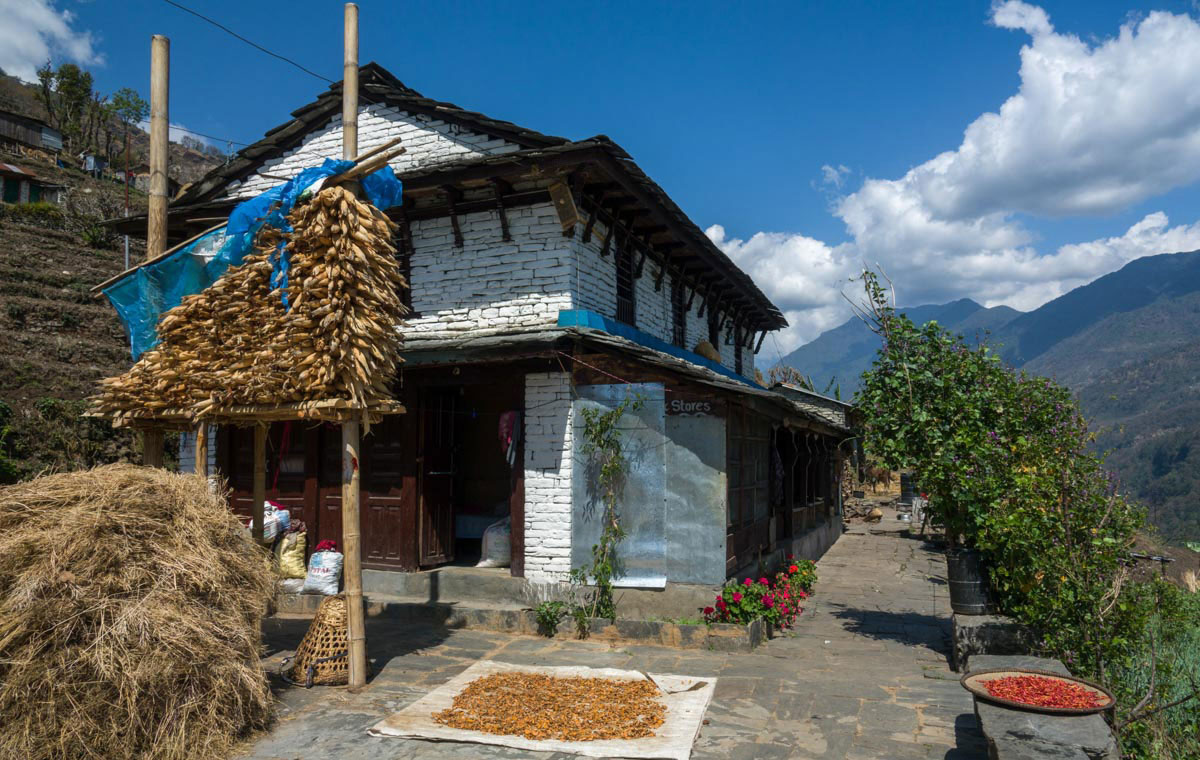
About Chitwan
Royal Chitwan National Park
History
Royal Chitwan National Park has long been one of the country’s treasures of natural wonders. The park is situated in south central Nepal, covering 932 square kilometers in the subtropical lowlands of the inner Terai. The area comprising the Tikauli forest, from Rapti river to the foothills of the Mahabharat, extends for an area of 175 square kilometers and was declared Mahendra Mriga Kunj (Mahendra Deer Park) by the late King Mahendra in 1959. In 1963, the area south of Rapti River was demarcated as a rhinoceros sanctuary. The area was gazetted as the country’s first national park in 1973. Recognizing its unique ecosystems of international significance, UNESCO declared RCNP a World Heritage Site in 1984. In 1996, an area of 750 square kilometers surrounding the park was declared a buffer zone which consists of forests and private lands. The park and the local people jointly initiate community development activities and manage natural resources in the buffer zone. The government has made a provision of plowing back 30-50 percent of the park revenue for community development in the buffer zone.
Features
The Chitwan valley consists of tropical and subtropical forests. Sal forests cover 70 percent of the park. Sal leaves are used locally for plates in festivals and religious offerings. Grasslands cover 20 percent of the park. There are more than 50 different types of grasses, including the elephant grass (Saccharum spp.), renowned for its immense height, growing up to 8 meters in height. The shorter grasses (imperata) are used for roof thatching as well as mats, rope and paper making.
A total of 68 species of mammals, 56 species of herpeto fauna and 126 species of fish have been recorded in the park. The park is especially renowned for its protection of one-horned rhinoceros, gaur, royal Bengal tiger, wild elephant, four-horned antelope, pangolin, gangetic dolphin, gharial crocodile, golden monitor lizard and python. The park harbors not only the world’s largest terrestrial mammal (wild elephant) but also the world’s smallest terrestrial mammal (pygmy shrew). A total of 544 species of birds has been recorded so far including 22 globally threatened species including critically endangered Bengal florican, slender-billed vulture, white rumped vulture and red headed vulture.
The park houses a diversity of ecosystems, including the Churia hills, ox-bow lakes, and the flood plains of the Rapti, Reu and Narayani Rivers. The Churia hills rise slowly towards the east from 150 meters to more than 800 meters. The western portion of the park is comprised of the lower but more rugged Someshwor hills. The park shares its eastern boundary with the Parsa Wildlife Reserve.
Tharus are the main indigenous ethnic groups in Chitwan. They are well known for their resistance to malaria. Traditionally they are farmers and practice their own unique tribal culture. A stroll or a ride through the Tharu village will provide an opportunity to see their traditional farming and relics. Traditional Tharu stick dance gives an insight into their culture
Climate
Conditions are subtropical with a summer monsoon from mid-June to late-September, and a relatively dry winter. Mean annual rainfall is 2400mm with about 90% falling in the monsoon from June to September. Monsoon rains cause dramatic floods and changes in the character and courses of rivers. Temperatures are highest (maximum 38°C) during this season and drop to a minimum of 6°C in the post-monsoon period (October to January), when dry northerly winds from the Himalaya and Tibetan Plateau are prevalent.
Trip Photos
Chitwan National Park
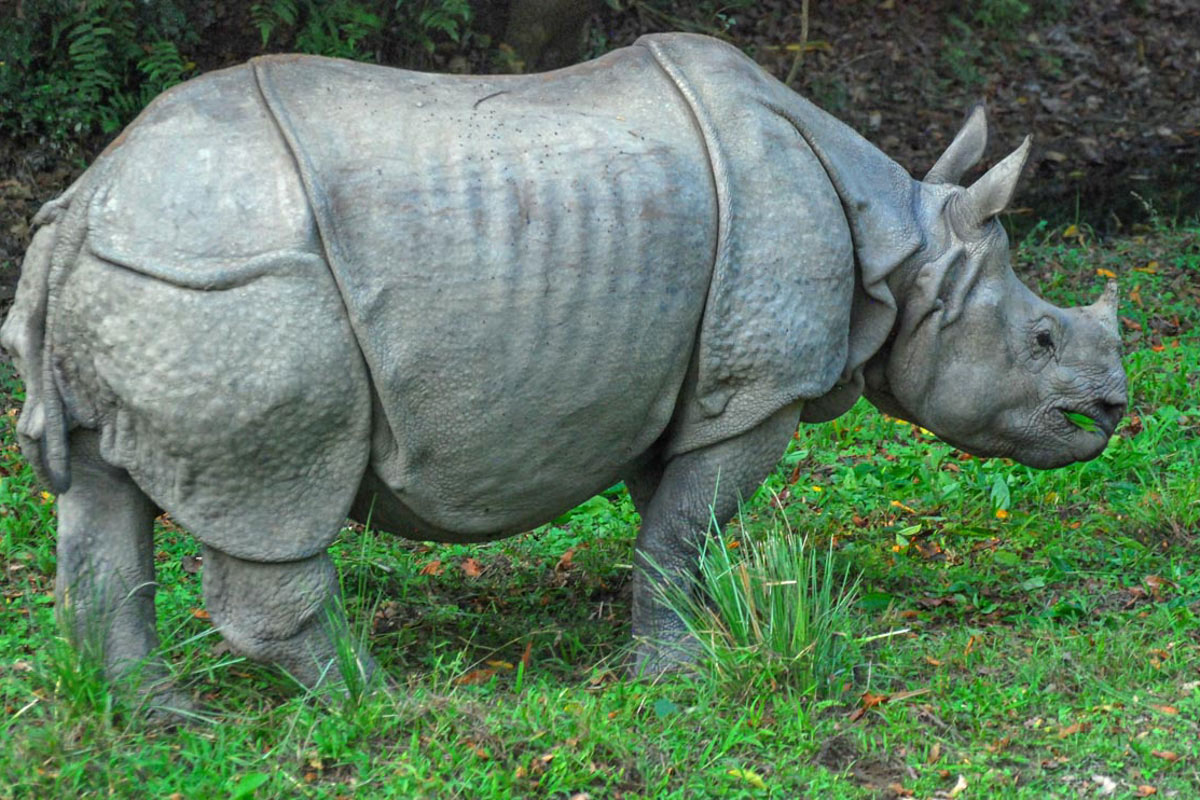
Kathmandu Tours
Not Enough of Nepal?
We highly suggest taking advantage of your trip to Nepal, adding on excursions into the Kathmandu Valley, Pokhara, Bandipur, Gorkha, the Annapurna Foothills, and Chitwan and Bardia National Park. Enjoy heritage tours, mountain biking, Kathmandu valley hiking, Himalayan panoramas with a hike down from the Chandragiri Cable Car, whitewater rafting, yoga and meditation courses, Nepali cooking classes, Buddhist or Hindu retreats, and much more. There are many wonderful, boutique, luxury, and heritage lodges in the Kathmandu Valley, and many options for world heritage sightseeing tours, bicycle trips, hikes, and craft-cuisine tours. Nepal boasts world-class restaurants, chic cafes, timeless alleyways to wander through, countless Hindu and Buddhist festivals, and lots of great shopping.
Don’t miss an Everest sightseeing flight or epic helicopter tour, sightseeing trips to Bhaktapur, Patan, and Panauti (Kathmandu Valley’s other historic and/or capital cities), a weekend at Shivapuri Heights Resort or Dwarikas in Kathmandu, a night at the Fort Hotel in Nagarkot for sunrise and sunset Himalayan panoramas, a spa and wellness getaway at the ultra-luxurious Dwarikas Dhulikhel Resort and visits to ancient temple and monastery complexes such as Namo Buddha, Changu Narayan, and Dakshinkali. Spend a night at The Old Inn in Bandipur or Three Mountain Lodge en route to Pokhara, or The Famous Farm in Nuwakot, and get to know Nepal’s Newar heritage.
Enjoy a luxury 3-6 day trek in the Annapurna Foothills, staying in the wonderful Ker & Downey luxury lodges. Relax in heritage style at Temple Tree Resort in Pokhara for some pampering at the spa and infinity pool, try out paragliding, zip-lining, and enjoy a morning of boating on the lake and the hike to Shanti Stupa. Once refreshed, drive to Chitwan National Park, spending a few nights at Maruni Sanctuary Resort or Tiger Tops Tharu Lodge for wildlife and bird spotting, river trips, and safaris in style. Tiger Tops also owns Karnali Lodge at Bardia National Park, reached by flight from Kathmandu, and there are nearby archeological sites to visit nearby.
Namaste!
Nepal Modules
Nepal & Kathmandu Modules | Customize Your Trip!
Kathmandu Valley Guided Sightseeing Day Tours
+ Kathmandu World Heritage Guided Sightseeing Tour (Full Day) | Pashupatinath, Boudhanath & Swayambunath ($125)
+ Kathmandu World Heritage Guided Sightseeing Tour (Half Day) | Pashupatinath & Boudhanath ($75)
+ Kathmandu World Heritage Sightseeing Car – No Guide (Morning or Evening) | Swayambunath ($35)
+ Kathmandu World Heritage Guided Walking Tour (Half Day) | Kathmandu Durbar Square ($50)
+ Kathmandu World Heritage Guided Tour (Half Day) | Patan Durbar Square ($65)
+ Kathmandu Valley World Heritage Sightseeing Tour (Full Day) | Bhaktapur & Changu Narayan ($135)
+ Kathmandu Valley Heritage + Craft Tour (Custom Tours)
+ Cycling Trip in Kathmandu Valley (Custom Trips)
+ Everest Express Sightseeing Flight ($225)
+ Everest Sightseeing Helicopter Tour (Custom Tours)
TOUR NOTE | Additional tour member + $30. Entrance fees not included.
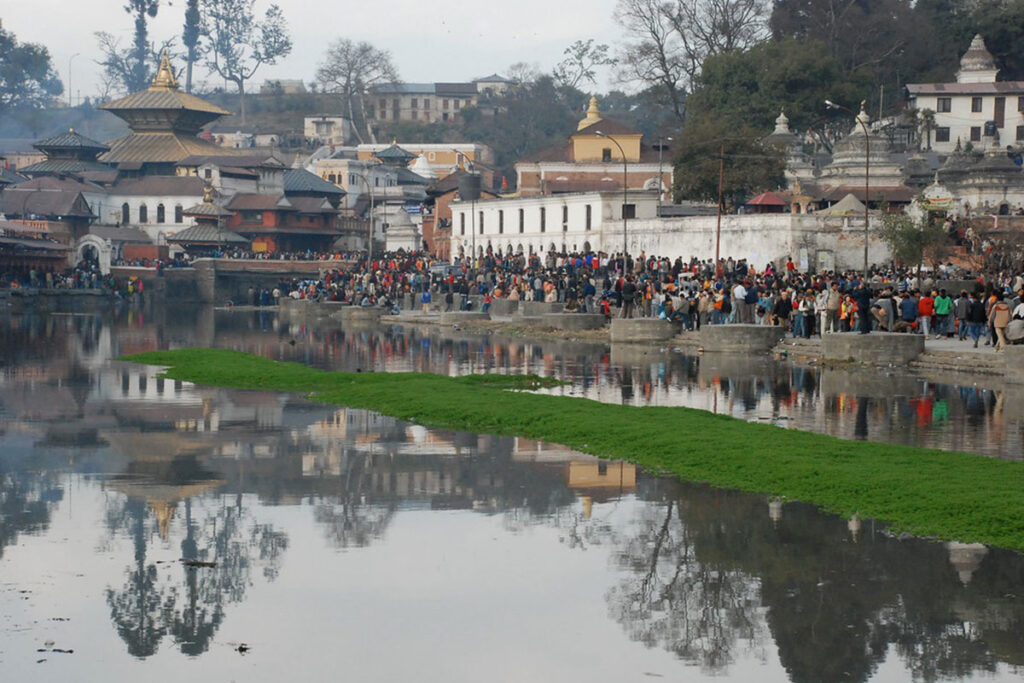
Kathmandu Heritage Multi Day Tours & Hikes
Kathmandu Valley | Heritage Treks & Tours – Nepal
Kathmandu | Full Day World Heritage Sightseeing Tour | Boudhanath, Pashupatinath & Swayambunath
Kathmandu is filled with World Heritage sites and sacred destinations, crowded with traditional neighborhoods and colorful festivals. Spend a few days exploring Nepal’s exotic capital and the history-laden Kathmandu valley. We can arrange sightseeing guide, vehicles and guides as required. See Kathmandu Heritage + Happenings for more details.
We recommend beginning with Pashupatinath in the early morning, and moving on to Boudhanath mid-morning. Hindu Pashupatinath on the sacred Bagmati river and its sacred temple complex is one of Nepal’s most important sites, a powerful cremation site and Nepal’s most important Hindu temple. Here, monkeys run up and down the steps of the burning ghats, and trident-bearing saddhus draped in burnt-orange and saffron sit serenely meditating, when they’re not posing for photos-for-rupees. Local guides can explain the significance of the complicated ceremonies. Please be respectful when taking photos.
Boudhanath, in the midst of traditional monasteries (gompas) and hung with long strings of multi-colored prayer flags, attracts Sherpas, Tibetans and tourists alike for daily circumambulations (koras) of the iconic stupa. The striking Buddha eyes of Boudhanath Stupa watch over a lively and colorful Tibetan community and attract pilgrims from all over the Himalayan Buddhist realm. There are wonderful spots for lunch at Boudhanath (Roadhouse Cafe has wood-oven pizzas and a breathtaking view of the stupa and colorful Nepals circling it), and it’s a good place to learn the technique of thanka painting and purchase a thanka (Buddhist mural). See also Bhaktapur for more options for shopping for thankas.
Wander through the many temples, pagodas, courtyards and the museum at Kathmandu Durbar Square, a timeless gathering spot and a UNESCO World Heritage site. Kathmandu Durbar Square, including the old royal palace, is Kathmandu’s ‘Palace Square’, a showcase for the world renown artisans and craftsmen of Kathmandu and a synthesis of Hindu and Buddhist palaces, temples, stupas and statues. The Malla and Shah kings ruled over the Kathmandu Valley during the centuries of the building of the layers of this Durbar Square. Along with their opulent palaces, the square surrounds numerous courtyards and temples, all works of art with intricate and often erotic carvings. Kathmandu Durbar Square is known as Hanuman Dhoka Durbar Square, a name derived from a statue of Hanuman, the monkey devotee of Lord Ram, at the entrance of the palace. The social, religious and urban focal point of the city, Durbar Square is often the site of festivals, marriages and other ceremonies such as Teej. Some important structures are Hanuman Dhoka Palace, Kumari Ghar (Abode of the Living Goddess), Taleju Temple, built between the 12th and 18th centuries, the 17th century stone inscription set into the wall of the palace with writings in 15 languages.
In the evening (take the interesting back streets from Durbar Square) climb the many steps to the gilded Swayambhunath stupa (known as the monkey temple) which rises from the Kathmandu valley floor at 1420 meters and is one of the holiest Buddhist sites in Nepal. Swayambunath, the ‘self created’ stupa, was founded over 2000 years ago at a time when the Kathmandu valley was filled by a large lake, with a single lotus in the center. Mythology says that Manjusri, a bodhisvatti, drained the lake with one cut of his sword and the lotus flower was transformed into the stupa. From its commanding views of Kathmandu, circumambulate Swayambunath’s white-washed stupa, painted with distinctive Buddha eyes, the complex a unique synthesis of Buddhism and Hinduism. Another interesting time to visit Swayambunath is in the mornings, when Nepalis visit the temple dedicated to the God of Smallpox to with colorful offerings for the goddess.
Stop to photograph reflections in Kathmandu’s many pokhari’s, or ponds, including the beautiful Rani Pokhari (queen’s bath) near New Road, and the Naga Pokhari (pond of the snake gods of the underworld) just beyond the palace gates. The many bathing ghats, square enclosures with steps leading down to water spouts, often decorated with naga heads, are also interesting and colorful gathering spots.
+Entrance Fees not Included for Single Person
Kathmandu | Half Day World Heritage Patan Durbar Square Sightseeing Tour
Visit the third of Kathmandu’s ancient capitals, known as ‘The City of Fine Arts’, best if you have an extra day in hand as Patan is also rich in cultural heritage, has many lovely roof-top cafes for lunch and world-class museums. Some of the highlights of Patan are its Durbar Square, the Krishna Temple within the palace complex of Patan (entirely made of stone, with 21 distinctive spires), and Hiranya Varna Mahavir, or the Golden Buddha Temple.
+ Entrance Fees not Included for Single Person
Kathmandu Valley | Full Day World Heritage Bhaktapur & Changu Narayan Sightseeing Tour
One more day in Kathmandu, with a sightseeing excursion by private vehicle to Bhaktapur. Bhaktapur which translates as ‘Place of Devotees’ and is also known as Bhadgaon, is an ancient Newar city approximately 15 kilometers east of the Kathmandu Valley. Bhaktapur is one of three ancient capitals of the Kathmandu valley, the capital of the Newar Kingdom and a city of artisans and craftspeople famous for its art and architecture: intricate carvings, sculptures, paintings, thankas, pottery, statues and temples, or pagodas. Bhaktapur has a well-preserved ‘durbar square’, or palace square, and has been named a World Heritage site by UNESCO because of its incredible temples, pagodas, wood carvings, stone carvings and metalwork. Bhaktapur is also famous for its yogurt, called curd in Asia, a taste which hasn’t been duplicated anywhere.
Spend the day exploring Bhaktapur and its rich cultural heritage, where a majority of enthnic Newaris live in traditional ways, and life seems to stand still. There are many great restaurants and cafes to rejuvenate, and it’s possibly the best spot in Kathmandu for purchasing a thanka after watching the technique, as well as shopping for endless other locally produced crafts. Bhaktapur is home to countless local festivals, so if you are lucky and arrive on a festival day, enjoy the timeless and colorful events unfold.
You’ll also visit at Changu Narayan, a few km from Bhaktapur and one of Kathmandu’s oldest Newari temple villages. Legend has it that Changu Narayan was given to the daughter, Champak, of a Kashmiri king of Nepal when she wedded the prince of Bhaktapur. The important Vishnu temple is one of the oldest temples in all of Nepal, and was damaged during the 2015 earthquakes.
+ Entrance Fees not Included for Single Person
Everest Sightseeing Mountain Flight
An hour long extravaganza of the world’s 8000 meter peaks. Airport Transfers not Included. (+$250 or Market Price)
Everest Sightseeing Helicopter Tour
Inquire for prices and options for a once in a lifetime helicopter trip flying right over Everest Base Camp, Kala Pattar, the Khumbu Glacier, plus incredible views of Everest, Lhotse, Nuptse, Cho Oyu, Makalu, Ama Dablam, Pumori and more! Cost per helicopter, option to stop at Everest View Hotel for an ‘Everest breakfast’. (+$Inquire for Options)
Cycling Trip Kathmandu Valley
Many options for day trips, or extended trips, in the Kathmandu Valley. We can customize a cycling trip for you in partnership with one of our knowledgeable partners in Kathmandu. (+$Inquire for Options)
Shivapuri Heights Cottages
A wonderful get away 20 km north of Kathmandu, Shivapuri Heights Cottages are stylishly designed and personal cottages built around a ‘common house’, where you can breakfast overlooking the stunningly beautiful Kathmandu valley. Massages available on request. (+$Inquire for Options)
Extra Days in Kathmandu | Customize your Journey!
We have plenty of great suggestions for extra days, or weeks, in Nepal! See our Nepal & Kathmandu Modules | Customize Your Trip! for ideas to put together the perfect journey.
We recommend Kathmandu Valley heritage tours to Bhaktapur or Patan (the Kathmandu Valley’s other historic capital cities), mountain biking, river rafting, yoga retreats, get-aways to Gorkha, Bandipur, Panauti or Namo Buddha to visit traditional hill villages, temples, monasteries and fortresses or a tour of the Newari temple of Changu Narayan and a night at the Fort Hotel in Nagarkot for sublime Himalayan panoramas!
Everest sightseeing flight or an epic helicopter tour over Everest Base Camp, a luxurious stay at Temple Tree Resort & Spa in Pokhara or Himalayan Front in Sarangkot, paragliding, hiking or zip-lining over Phewa Lake, a spa + wellness getaway at Dwarikas Resort in Dhulikhel, a relaxing, luxury wildlife excursion to Chitwan National Park staying at Tharu Lodge or Maruni Sanctuary Lodge, a chic wildlife safari in Bardia National Park at Tiger Tops, a weekend of adventure, sauna and pampering at The Last Resort or 5-star treatment in historic Dwarika’s Heritage Hotel in Kathmandu.
Kamzang Journeys can customize any of these wonderful excursions for you!
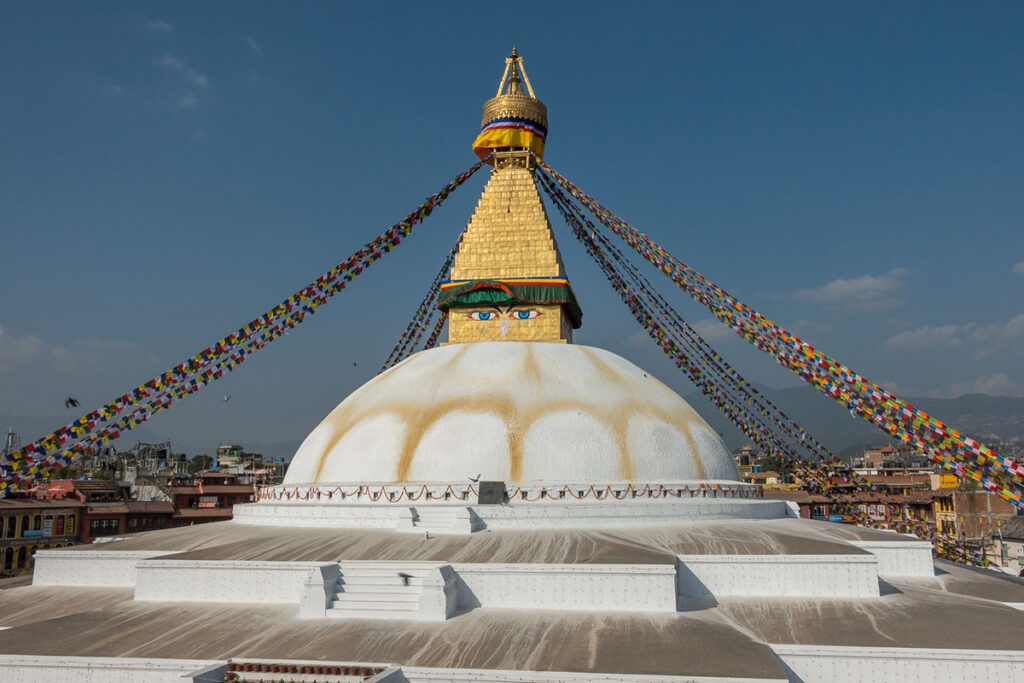
Everest Heli Tours
Everest Helicopter Tour Kwondge | Dinner Sunset & Sunrise over Everest – Yeti Mountain Home
An epic private helicopter tour for an extra day in the spectacular Khumbu region. Sunset dinner and sunrise breakfast overlooking some of the best Himalayan views on the planet! Board your private helicopter from Namche for the quick flight to Kwongde YMH Lodge, and enjoy lunch overlooking this vast panorama of peaks. Views include some of the highest peaks on the planet, including Everest, Lhotse, Makalu, Cho Oyu, Gyajung Khang (the highest peak under 8000m), and the majestic Ama Dambam. From the YMH Lodge, you can look down on Kwonde Lake, generally hidden, and up the awe-inspiring Khumbu valley. The Kwongde YMH (Yeti Mountain Home) is a luxury lodge, one of the world’s highest hotels in one of the Himalaya’s most dramatic locations. Your epic helicopter tour finishes back in Namche Bazaar, but you have the option to charter the helicopter back to Lukla or Kathmandu.
+ Price Per Helicopter – Namche to Namche ($1800)
+ Max 4 Passengers
+ Price Per Person Yeti Mountain Home – Breakfast + Dinner ($175)
+ Single Supplement ($75)
Everest Mountain Helicopter Sightseeing Tour | Namche to Namche | Lukla, Everest Base Camp, Cho La Pass (Gokyo Valley), Renjo La Pass (Thame Valley) & Namche
A once in a lifetime helicopter tour of the Everest region’s spectacular peaks, glaciers, and Himalayan passes! Your private helicopter picks you up in Namche Bazaar, from where you will fly over the Khumbu Glacier and to Everest Base Camp, as well as the incredible Everest icefall. You will have a chance to stop on Kala Pattar for photos of this spectacular setting. Back in your helicopter, your flight path takes you over Dzongla Lake, the glaciated Cho La pass, and into the stunningly beautiful Gokyo valley, flying low over the turquoise Gokyo Lake, with another touch down to splash some sacred lake on yourself before crossing the Renjo La pass to the traditional Thame valley, the old trade route to Tibet. Your epic helicopter tour finishes back in Namche Bazaar, but you have the option to charter the helicopter back to Lukla or Kathmandu.
+ Price Per Helicopter ($2750) – Namche to Namche
+ Max 4 Passengers
Everest Mountain Epic Sightseeing Tour | Kathmandu to Kathmandu | Lukla, Everest Base Camp, Cho La Pass (Gokyo Valley) & Namche
The full helicopter deal, all the way from Kathmandu to Everest Base Camp, and much more! A once in a lifetime helicopter tour of the Everest region’s spectacular peaks, glaciers, and Himalayan passes! Your private helicopter picks you up at Tribhuvan Airport in Kathmandu, from where you will fly up to the fabled Tenzin Norgay airport in Lukla. After a cup of tea in Lukla, you will reboard your helicopter and fly over the Khumbu Glacier and to Everest Base Camp and the sublime Everest icefall. You will have the unique chance to stop at Everest Base camp for photos of this spectacular setting.
Back in the helicopters, your flight path takes you over beautiful Dzongla Lake, the glaciated Cho La pass, and into the stunningly beautiful Gokyo valley, flying low over the turquoise Gokyo Lake and down the Gokyo Valley. Your epic helicopter continues by flying back over Namche Bazaar, and back through Nepal’s lush middle hills to Kathmandu.
+ Price Per Helicopter ($5000) – Kathmandu to Kathmandu
+ Max 4 Passengers
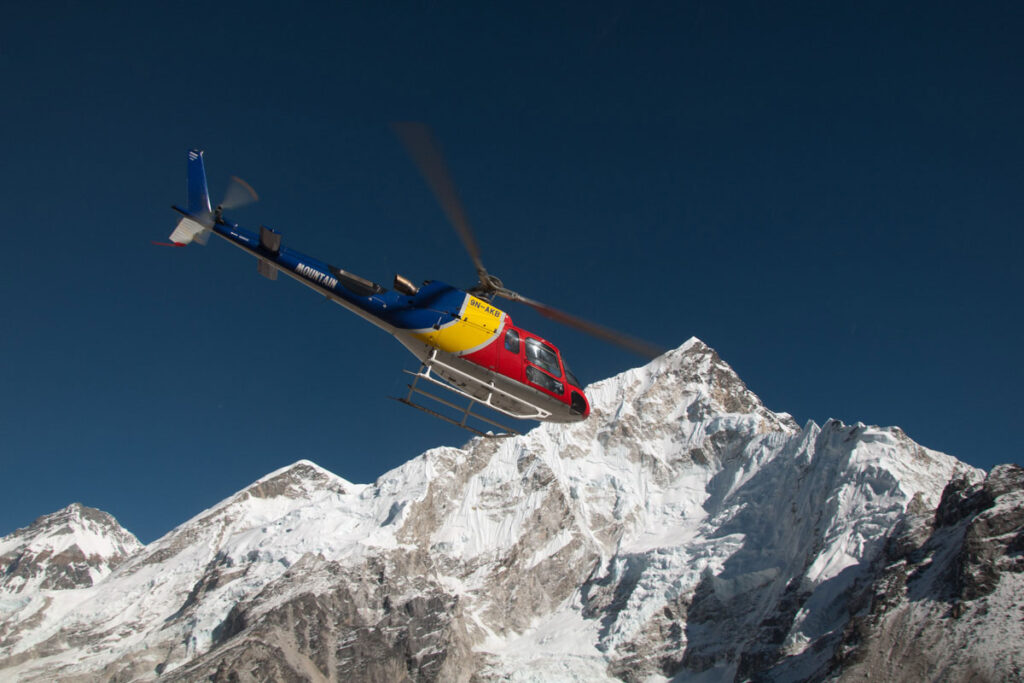
Great Stays
BOUTIQUE & LUXURY HOTELS | KATHMANDU VALLEY
Kathmandu Guest House
Kathmandu Guest House
The Kathmandu Guest House is one of Kathmandu’s first hotels, originally a Rana Palace. Located in the heart of Thamel, the Kathmandu Guest House is a beautiful, lively hotel with a large garden and lovely outdoor cafes, centrally located in Thamel with a wide range of restaurants, cafes, yoga and shopping surrounding it. KGH offers a wide selection of rooms, including their wonderful deluxe rooms.
“Travelers know that the frenetic pace of a crowded city like Kathmandu needs an escape. The Kathmandu Guest House, a converted Rana dynasty mansion with fragrant gardens and airy corridors, has provided the peaceful refuge of choice since 1967. Since the days of being the first and only hotel in Thamel, the packed tourist district of Kathmandu, it’s become something of an institution. It’s close to everywhere and its gate is the meeting point that nobody can mistake. As a guidebook put it, “Kathmandu Guest House acts as a magnet for mountaineers, pop stars, actors and eccentric characters.” Even the Beatles stayed here in 1968. Whether you’re returning from the mountains or arriving from the airport, come and relax at the courtyard restaurant, order a cup of fine Italian coffee or a chilled Gorkha Beer, and escape for a moment in the historic surroundings of Kathmandu’s most loved guesthouse.”
Kathmandu Guest House Timeline
KGH History
Dwarika’s
Dwarika’s Hotel
Dwarika’s, Kathmandu’s premier hotel built and decorated with traditional Kathmandu valley architecture, is an oasis of calm located near the airport, where you can relax by the pool, visit the award-winning spa, enjoy the serene, historic surroundings and dine at one of their world-class restaurants.
“Dwarika’s Hotel was registered in 1977, with the idea of reviving the architectural splendour of the valley. All the terracotta work was made in the valley, using local clay and skills. The couple also incorporated elements of Nepal’s diverse cultural heritage, including those from beyond the valley, when designing the rooms. The furniture was crafted by families of traditional carpenters, and the linen, textiles and embroideries were hand woven and used Nepali patterns. In all purposes, Dwarika Das Shrestha took some of the finest elements of Nepali crafts, and presented them in a way that had not been done before. In explaining his vision, he once stated: “My project is to recreate a 15th-17th century environment where tourist and Nepali alike would have a sensation of the original. The hotel as a commercial enterprise is merely a vehicle to finance and carry my dream forward.”
History of Newari Culture in Kathmandu. Inspiration for the Heritage Architecture of Dwarika’s
Newari History in Kathmandu
History of Dwarika’s
Dwarika’s History
Dwarika’s Resort Dhulikhel
Dwarika’s Resort
A top-notch resort, with a wonderful spa, and wellness, and yoga retreats, on the Kathmandu Valley rim. “With the belief in the need for maintaining harmony between the body, mind, spirit and the planet for a peaceful, healthy and balanced life; the Dwarika’s Resort is built on the philosophy of respecting nature and self. The resort takes its inspiration from ancient Hindu Vedic scriptures (Vedas), Buddhist medicine and traditional Himalayan knowledge. The Himalayan belt has been home to holistic healing and wellbeing for more than three thousand years. The region’s approach to wellbeing, its serene natural beauty and rare medicinal herbs has attracted great sages through time. The Hindu Vedic scriptures describe Ayurveda, the science of life, as a comprehensive approach to wellbeing that encompasses the study of biology, spirituality, psychology, astronomy, nutrition and beauty. Originating from the same roots the Buddhist approaches to wellbeing also follows similar path and views health as harmony between the mind, body, spirit and one’s environment.
The resort has been designed based on the knowledge of these ancient understanding about holistic wellbeing with all the spaces being consecrated and brought to life. The lifestyle spaces within the resort are designed to attract positive energy and keep negative energy at bay. When you go around the resort you can find details we have placed in various spaces to ensure the energy within the resort is as positive as possible. For example, the resort is surrounded by Cactus (Ketuki), which is believed to cleanse the space around it of all the negative energy and attract positive energy instead. Hence, adding to the calm and nurturing environment offered within the resort. The resort also offers various activities within these spaces to enhance and add value to our guests’ experience.”
Yak & Yeti
Yak & Yeti
Yak & Yeti is one of Kathmandu’s historic 5-star hotels, steeped in history, with a lovely pool and garden, located just off Durbar Marg, a tree-lined, upscale road of shops and hotels. ” Yak & Yeti opened in 1977 as a 120 room, 5-star hotel – the first of its kind in Nepal. A new wing of an additional 150 rooms was built in harmony with the architectural features of the old palace, Lal Durbar, bringing the room total to 270. The whole hotel is a sumptuous array of beautiful artifacts, art, and traditionally crafted fixtures. Attention to detail has been meticulously considered throughout, giving the feeling you aren’t just in a hotel as much as an art gallery or museum. Over the years the hotel has been upgraded and extended and now boasts a shopping arcade, a swimming pool, two tennis courts and a state-of-the-art fitness center and luxury spa.”
Hyatt Regency
Hyatt Regency
The Hyatt is a stylish, 5-star hotel located near Boudhanath, with a large pool, a great buffet breakfast, a gym and a mix of Buddhist and Hindu decor in the lobby and rooms. “Hyatt Regency Kathmandu is a five-star luxury hotel and resort in Kathmandu, set on 37 acres of landscaped grounds and created in the traditional Newari style of Nepalese architecture. This beautiful hotel and resort is located on the road to the Boudhanath Stupa: the most holy of all Tibetan Buddhist shrines outside of Tibet and a UNESCO World Heritage Site located within a five-minute walk from the hotel. The hotel is just 4km (2.4m) from the Tribhuvan International Airport and 6 km (3.7m) from the city center of Kathmandu.”
Hotel Tibet
Hotel Tibet
“Since 1998, Hotel Tibet has set the standard for showcasing the warmth of Tibetan hospitality. Newly renovated post-COVID, we have worked towards merging modern elements with traditional Tibetan aesthetic to provide you with the utmost convenience and comfort and to make your stay with us a memorable experience. We have newly-renovated rooms, divided into deluxe, club, and suite categories that combine contemporary and traditional Tibetan designs. Our rooms are especially designed with your comfort in mind, featuring plush bedding, modern furnishings, and elegant decor.”
Dusit Princess
Dusit Princess
Kathmandu’s BEST rooftop bar, restaurant and pool. Brother of the owner of Hotel Tibet, which shares the property. “Make Dusit Princess Kathmandu your base for exploring Nepal’s vibrant capital. Comfort, value and convenience will define your stay, with warm Thai and Nepalese hospitality woven into every moment. Conveniently located in upmarket Lazimpat, the hotel has international restaurants and Narayanhiti Palace Museum on its doorstep.”
Marriott
Marriott
The Marriot was completed in 2020, located just near Nag Pokhari, with Kathmandu’s best buffet! “Retreat to Kathmandu Marriott Hotel, a 214-room contemporary hotel in the capital city of Kathmandu. Settle into spacious, well-appointed rooms and suites, many with views of the Himalayan range. Dine in our hotel restaurants, featuring International cuisine at Thamel Kitchen and Asian cuisine at Edamame. Relax at Raksi Music Bar with delicious food and beverages overlooking our waterfall terrace. Get pampered in our full-service hotel spa and salon, take a dip in our outdoor pool or work out in our 24-hour fitness center.”
Sheraton Hotel
Sheraton Hotel
One of Kathmandu’s great rooftop bars and pools! “Surrounded by the Himalayas, The Sheraton Kathmandu Hotel is conveniently located along the city’s main road, Kantipath. Once the Royal Palace for the kings of Nepal, The Narayanhiti Palace Museum is nearby as are embassies, banks and corporate offices. Tribhuvan International Airport is forty minutes away.
Kathmandu’s most popular tourist area, Thamel is located adjacent to the hotel and is filled with restaurants, bars, cafés and shops. In addition to traditional woolen items, pashmina shawls and scarves, as well as mountaineering equipment, you can savor some delightful Nepalese cuisine, including dumplings called momos, dal, and kwati, a delicious Newari curry soup made with a variety of beans.
This 20,000 SM GFA, 218-key Sheraton Hotel is located on a 6,647 SM site in the center of Kathmandu. The hotel includes food and beverage, a 900 SM banquet hall, meeting rooms, spa and gymnasium facilities and back-of-house areas.”
The Terraces
The Terraces
“The Terraces Resort and Spa is a luxury resort in Nepal, offering stunning views of the Kathmandu Valley and majestic Himalayas located near the border of Bhaktapur with easy access from Lalitpur. We provide the perfect environment to unwind, reconnect with nature and celebrate life’s special moments. Our friendly and professional staff is dedicated to catering to your every need, guiding you to discover the best of Nepal’s culture and nature through bespoke activities and tours. Immerse yourself in the historical sites of Bhaktapur or venture into the scenic landscapes of Lakuri Bhanjyang, creating unforgettable experiences that embrace the essence of Nepal. The Terraces is not just a luxury resort in Kathmandu – it is a destination where you can savor life to the fullest.
The resort, located just 16km from Kathmandu’s Tribhuvan International Airport, fuses international sensibilities with the best of what Nepal has to offer: Stunning mountain views, fresh air, wide open spaces and organic food. Each spacious room or suite comes with a terrace balcony. The only barrier between you and the beautiful world outside is floor-to-ceiling windows.”
BOUTIQUE HOTELS
There are many other boutique and character-filled hotels and guesthouses around the Kathmandu Valley. Just a few that we like listed, but this is not AT ALL an extensive list.
KATHMANDU | THREE CAPITALS
Potala Guesthouse – Thamel
Hotel Roadhouse – Thamel
Kantipur Temple House – Thamel
Nepali Ghar – Thamel
Aloft by Marriot – Thamel
Hotel Mulberry – Thamel (Pool)
1905 Suites – Nag Pokhari
Hotel Manaslu – Lazimpat
Hotel Shambala – Bainsbari – Maharajganj (Pool)
Babar Mahal Vilas – Babar Mahal
Hotel Padma – Boudhanath
Rokpa Guest House – Boudhanath
Hotel Shambaling – Boudhanath
Hotel Tibet International – Boudhanath
Hotel Lotus Gems – Boudhanath (Pool)
Cozy Nepal – Patan
Pahan Chhen – Patan
Traditional Stay Patan – Patan
The Inn Patan – Patan
Traditional Homes | Swota – Patan
Peacock Guest House – Bhaktapur
Hotel Heritage – Bhaktapur
KATHMANDU VALLEY & AROUND
The Fort Resort – Nagarkot
Hotel Mystic Mountain – Nagarkot
Gaia Holiday Home – Dhulikhel
Gokarna Forest Resort – Gokarna
Shivapuri Heights Cottages – Budhanilkanta, Shivapuri
The Old Inn – Bandipur
The Famous Farm – Nuwakot
Gorkha Gaun Resort – Gorkha
Terraces Resort – Lhakuri Bhanjyang Lamatar
Balthali Village Resort – Panauti
Park Village Resort – Budhanilkhanta (Pool)
POKHARA & AROUND
Begnas Lake Resort – Begnas Lake (Pool)
Hotel Karuna – Pokhara
Temple Tree Hotel & Spa – Pokhara (Pool)
Lakeview Resort – Pokhara
Hotel Barahi – Pokhara (Pool)
Summit River Lodge – Kurintar (Kathmandu – Pokhara Highway)
Ghale Gaun Homestay – Ghale Gaun (Near Besi Sahar)
FARMHOUSES & HOMESTAYS
Namo Buddha Resort – Namo Buddha
Herb Nepal – Bhaktapur
Nagarkot Farmhouse – Nagarkot
Srijana Farms – Tansen, Palpa
The Bosan Farmhouse – Bosan Danda
Almost Heaven Farm – Ilam
Barpeepal Bisauni Homestay – Ilam
KATHMANDU POOLS
Hyatt Regency – Boudhanath
Dwarika’s Hotel – Near Airport
Park Village Resort – Budhanilkhanta
Hotel Shanker – Lazimpat
Hotel Shambala – Bainsbari – Maharajganj
Marriott – Nag Pokhari
Yak & Yeti – Durbar Marg
Hotel Mulberry – Thamel
Photos
KIM BANNISTER PHOTOGRAPHY | HIMALAYAN TREKS, CYCLE TRIPS & TRAVELS
Kim Bannister Photography
CYCLE THE HIMALAYA PHOTOS
Guided Cycling Trips
KAMZANG JOURNEYS | ALL ABOUT US IN PHOTOS
Explore Kamzang Journeys
KAMZANG JOURNEYS | YELLOW TENT PHOTOS
The Yellow Tent of Eternal Happiness

HIMALAYAN WILDLIFE, BIRDS & FLOWERS PHOTOS
Himalayan Wildlife, Birds & Plants
HIMALAYAN DESIGN & CULTURAL PHOTOS
Himalayan Design & Cultural Photos
KAMZANG JOURNEYS GROUP PHOTOS
Kamzang Journeys Groups
KAMZANG JOURNEYS STAFF PHOTOS
Kamzang Journeys Staff
THE KAMZANG FUND & KAMZANG KIDS PHOTOS
The Kamzang Fund

NEPAL JOURNEYS PHOTOS
Nepal Journey
INDIA JOURNEY PHOTOS
India Journeys
TIBET JOURNEYS PHOTOS
Tibet Journeys
BHUTAN JOURNEYS PHOTOS
Bhutan Journeys
MYANMAR (BURMA) JOURNEYS PHOTOS
Myanmar (Burma) Photos
MONGOLIA JOURNEYS PHOTOS
Mongolia Journeys
SOUTHEAST ASIA PHOTOS
South East Asia Photos
